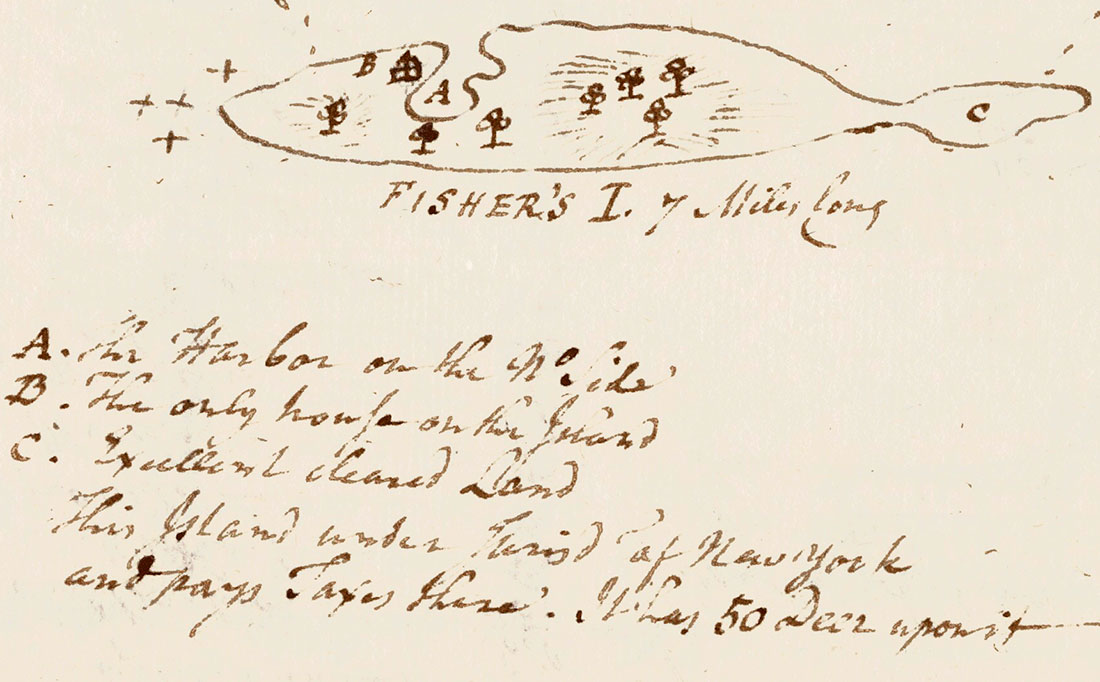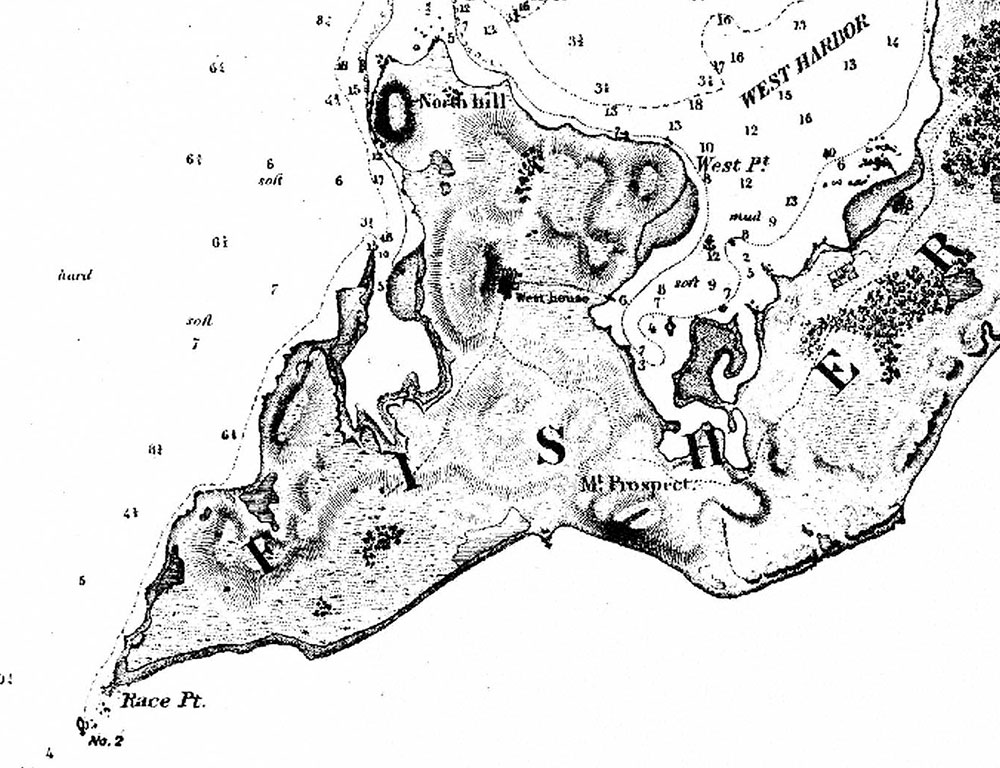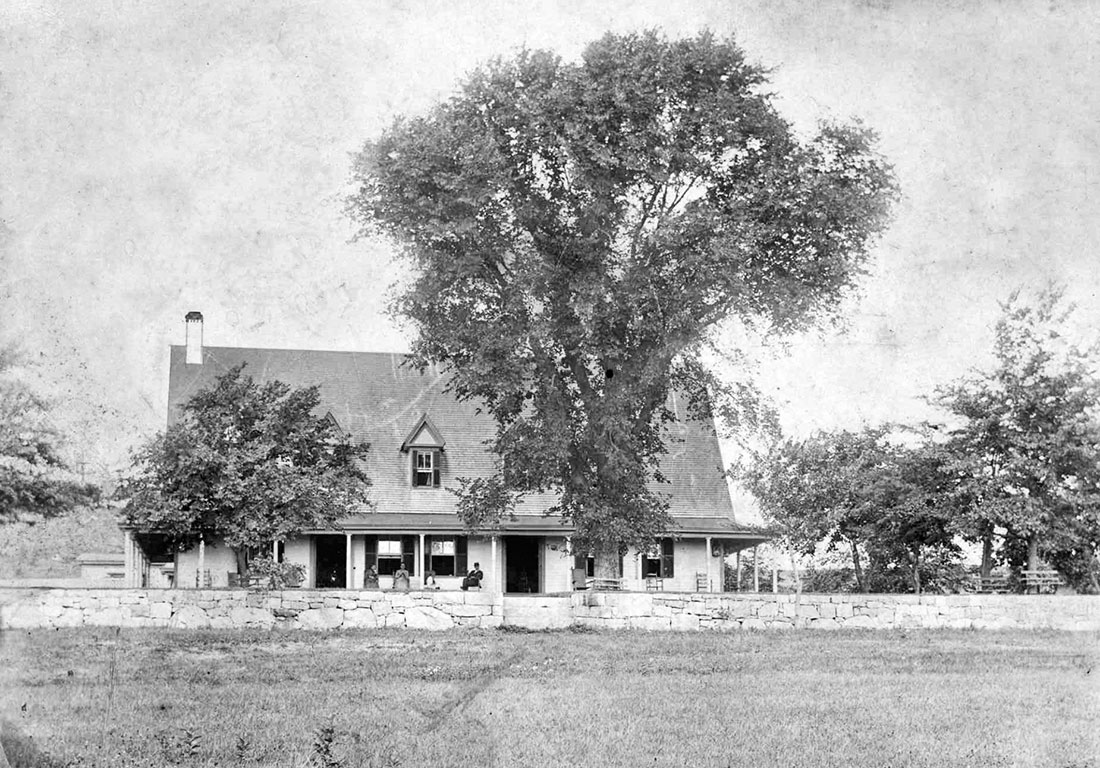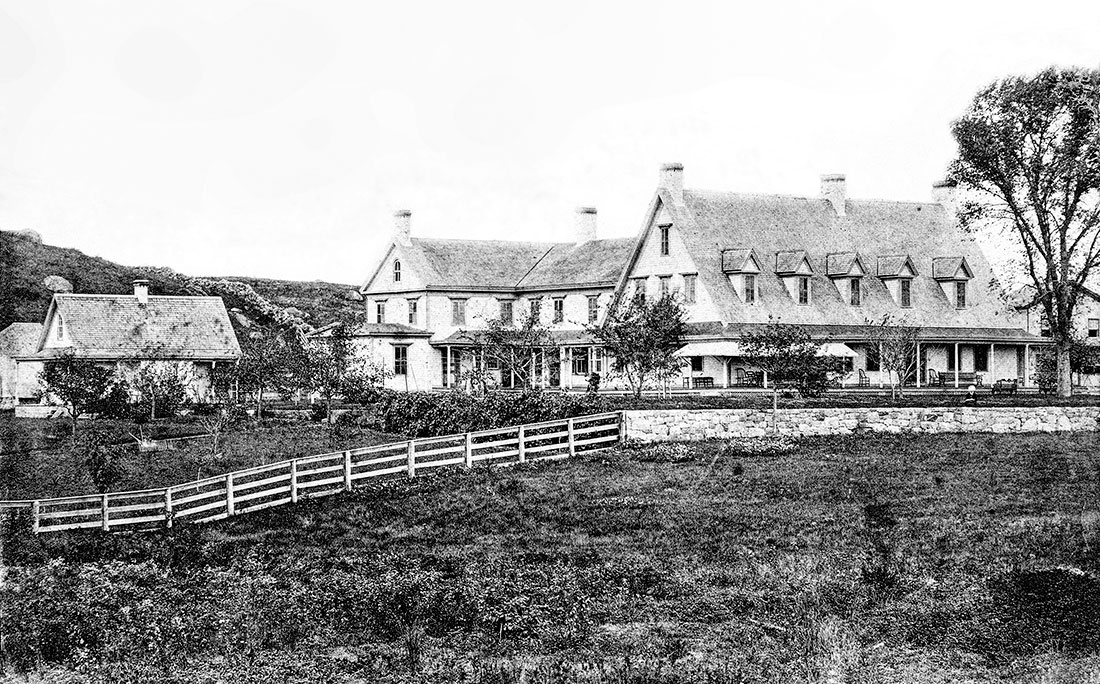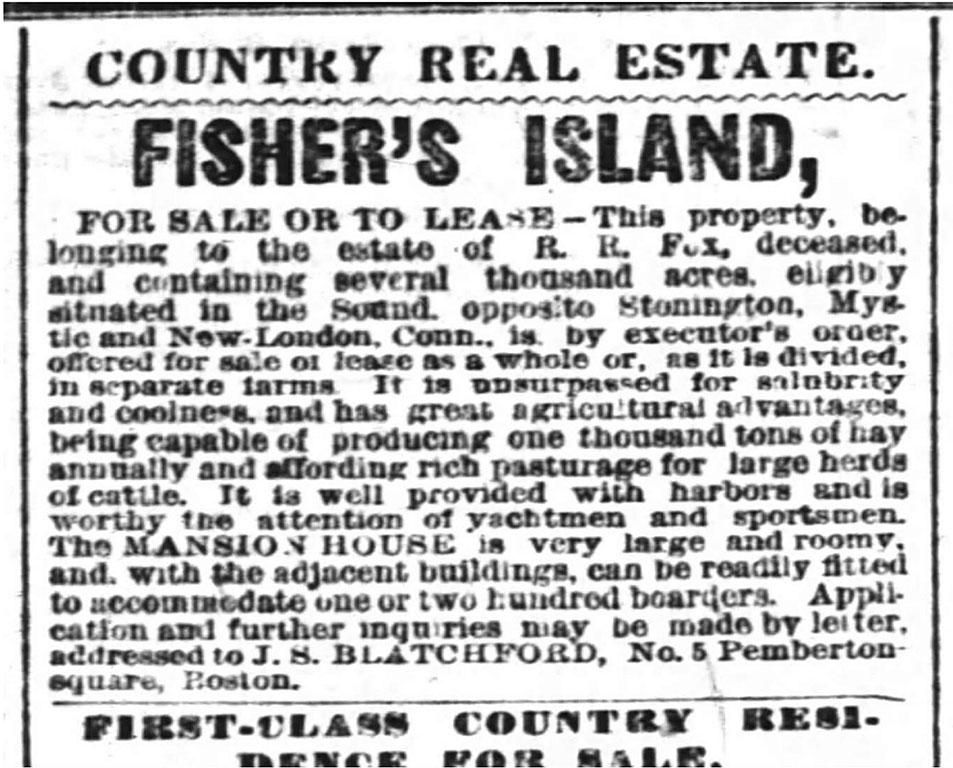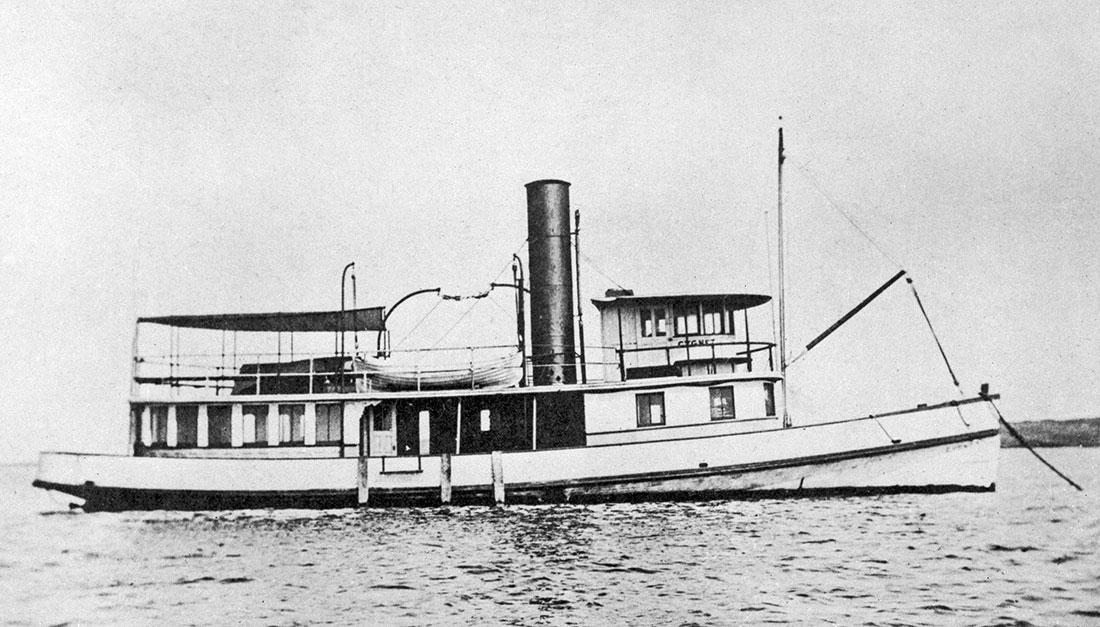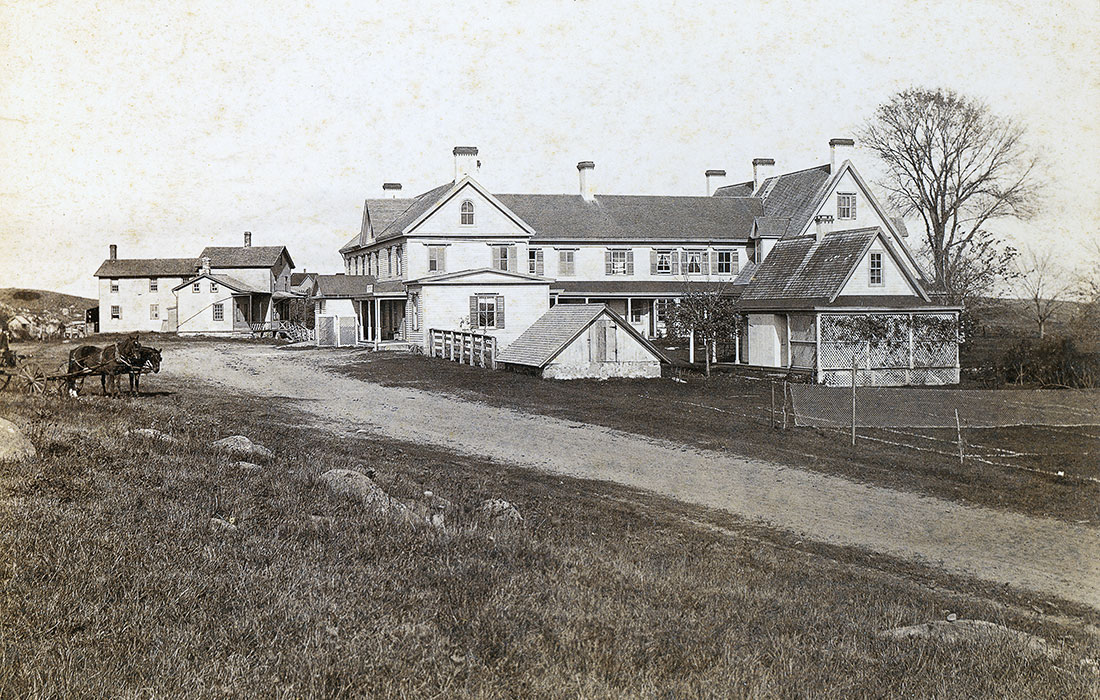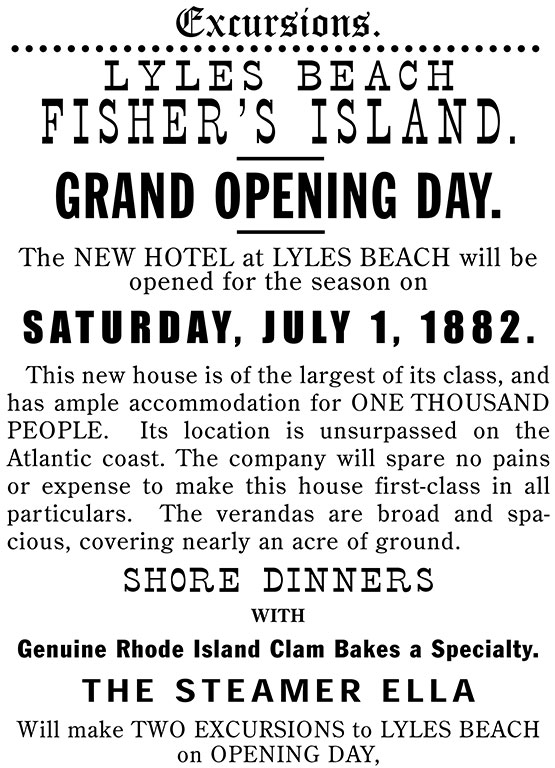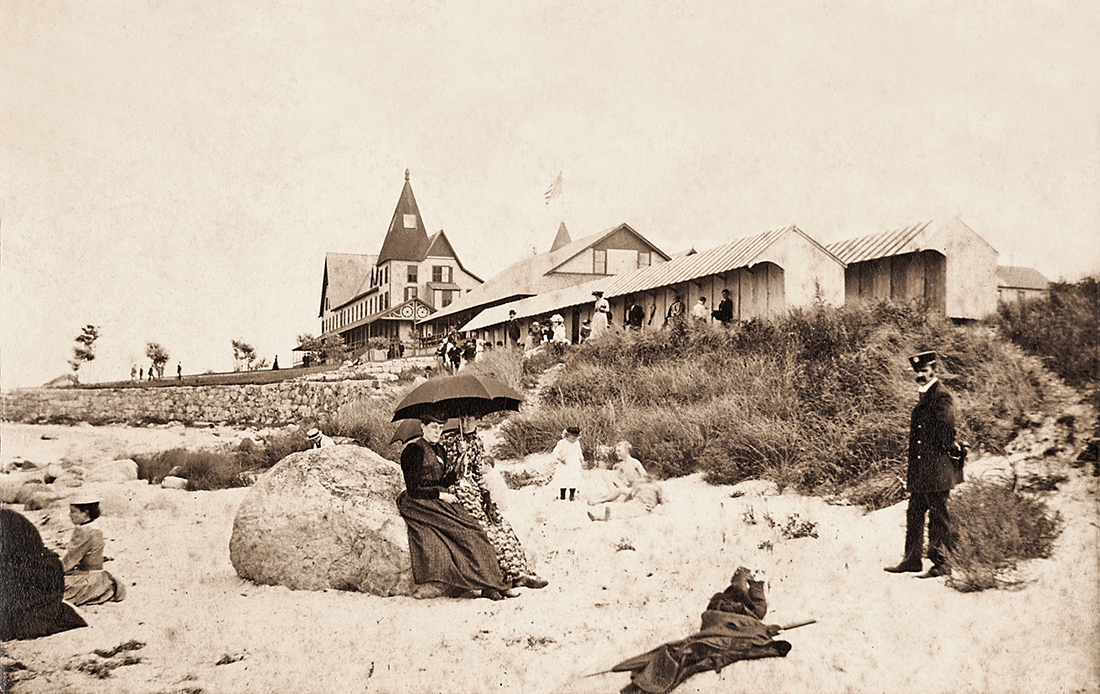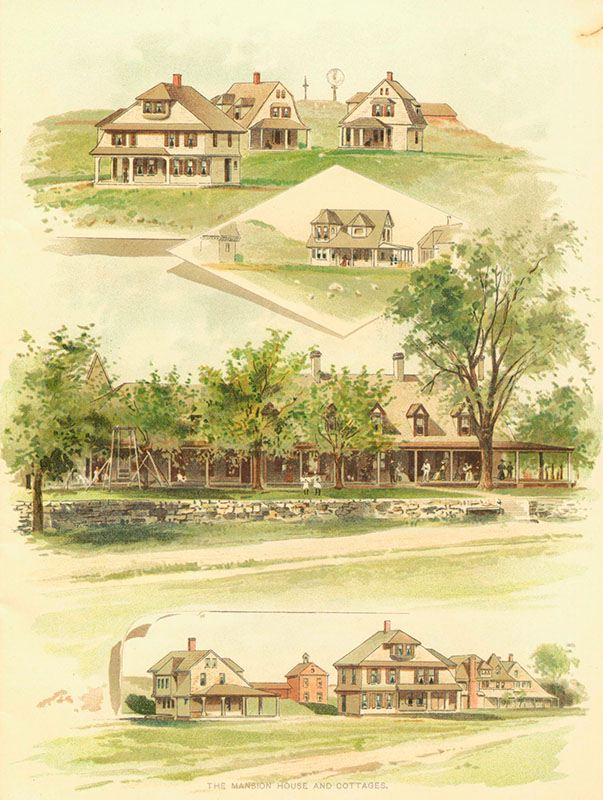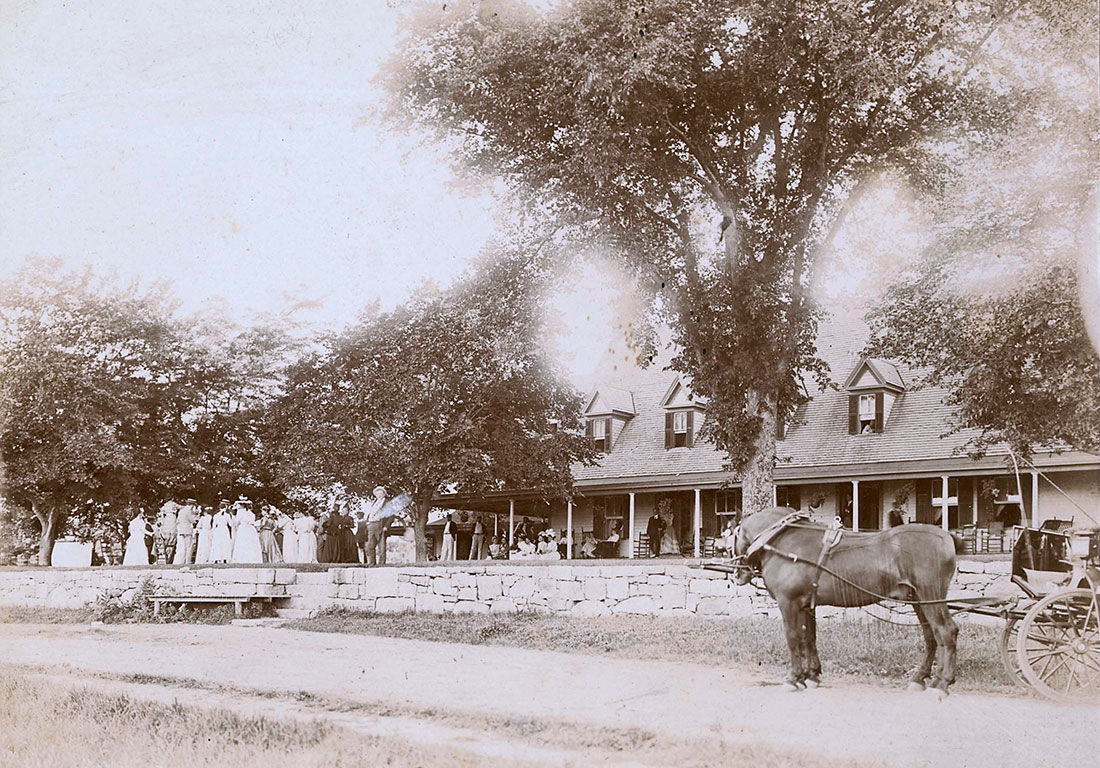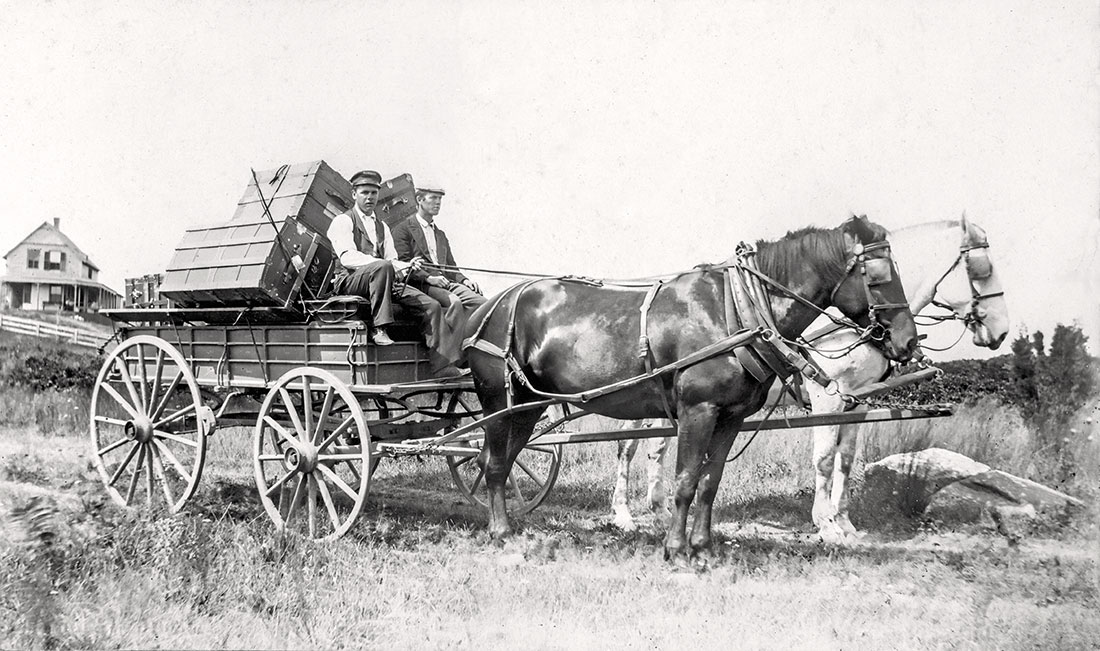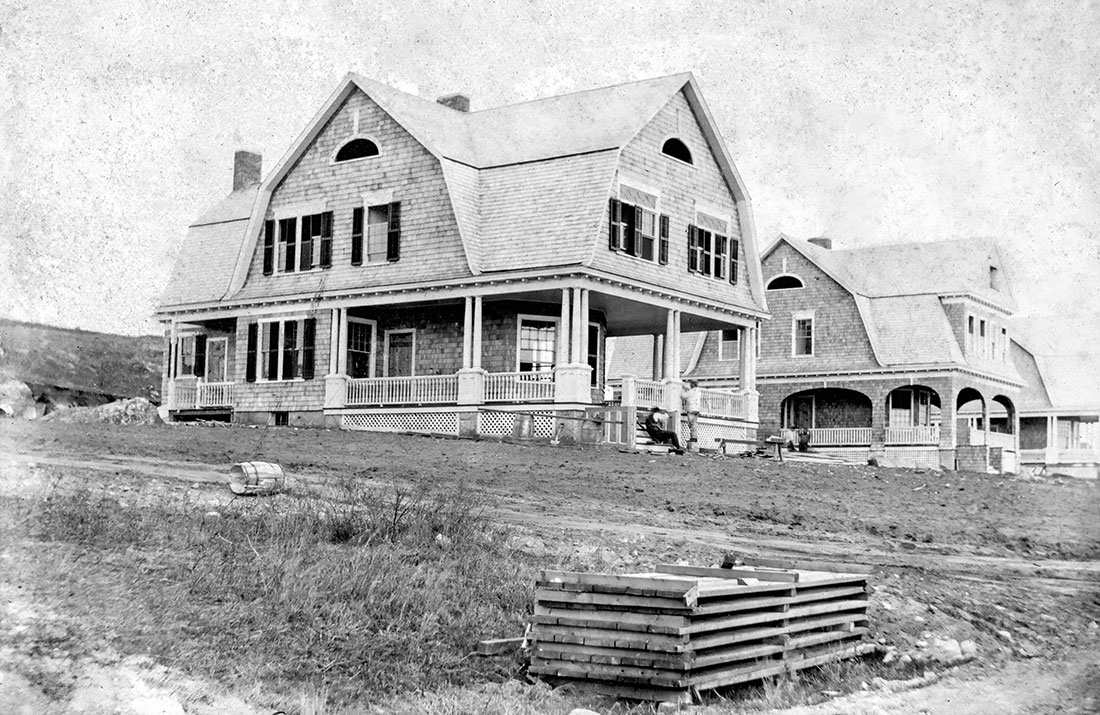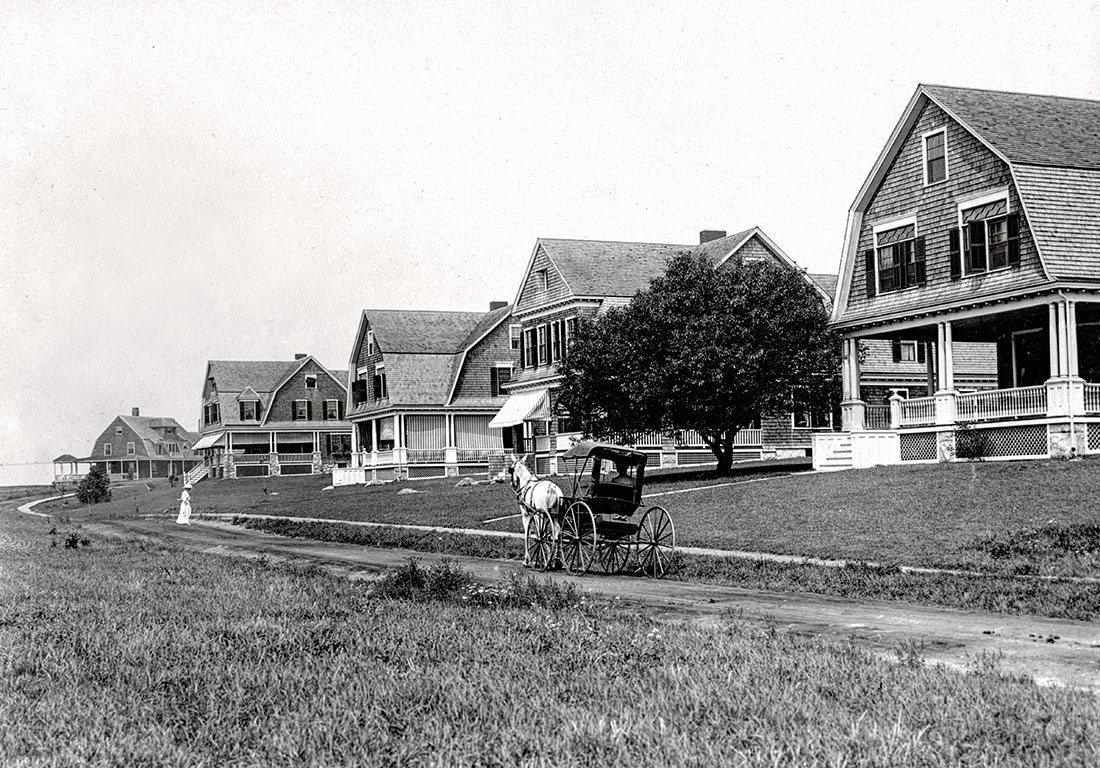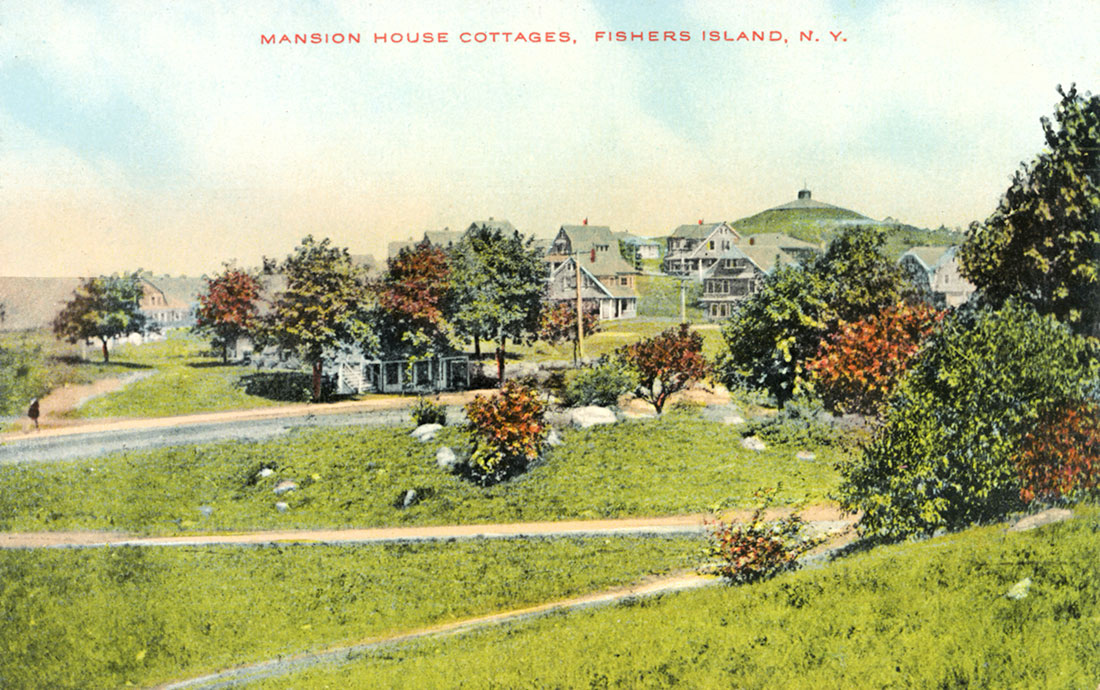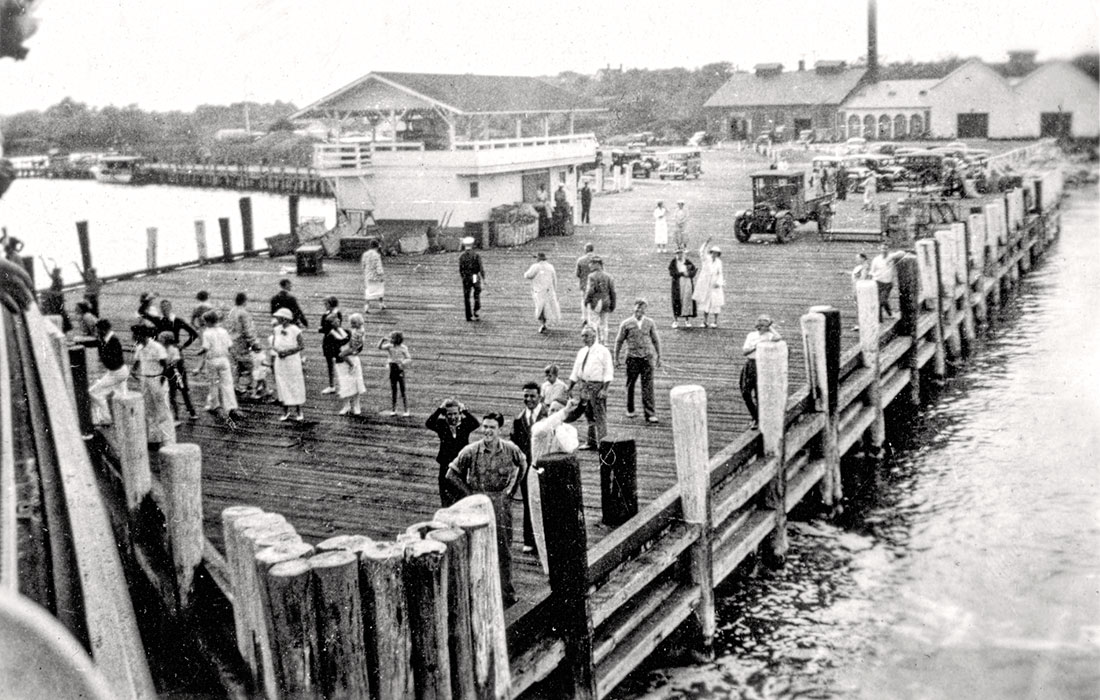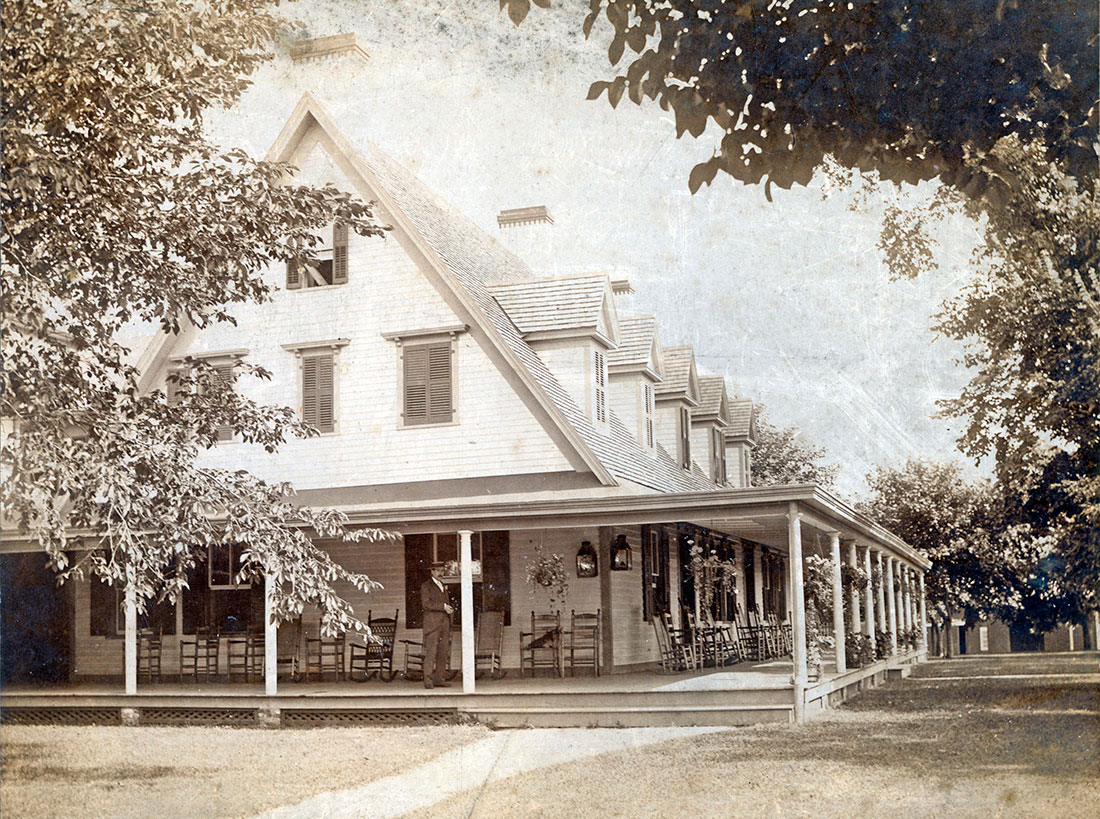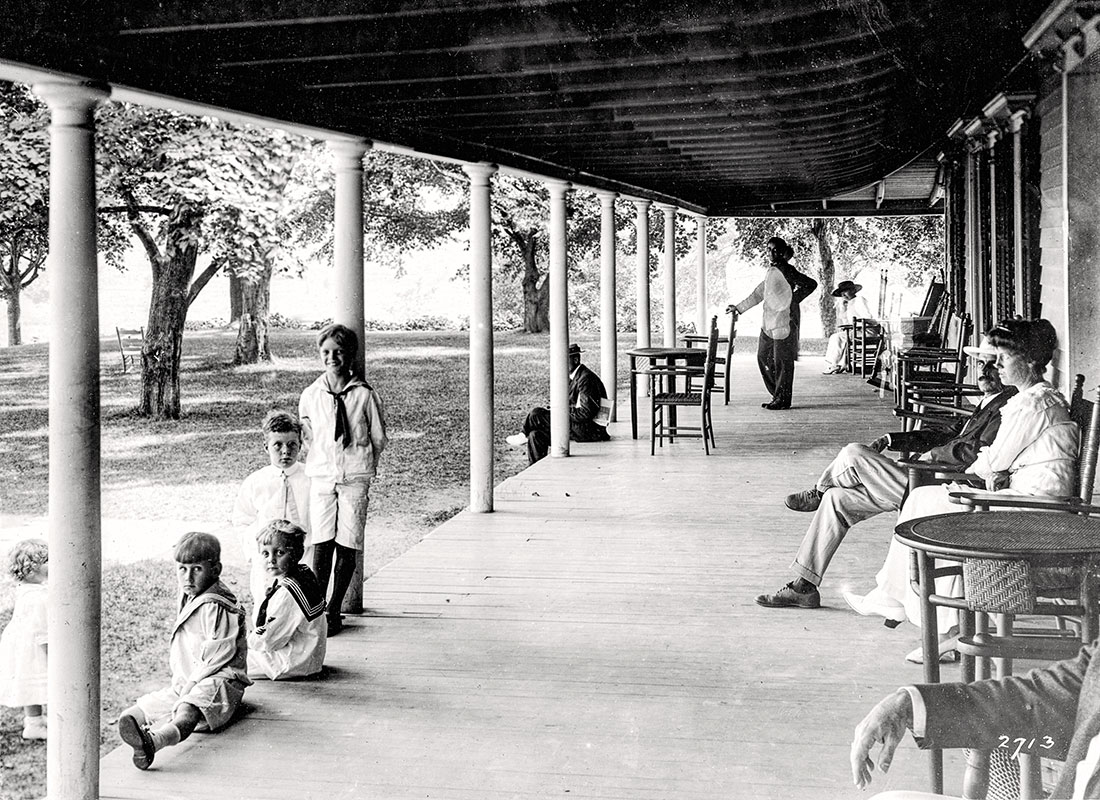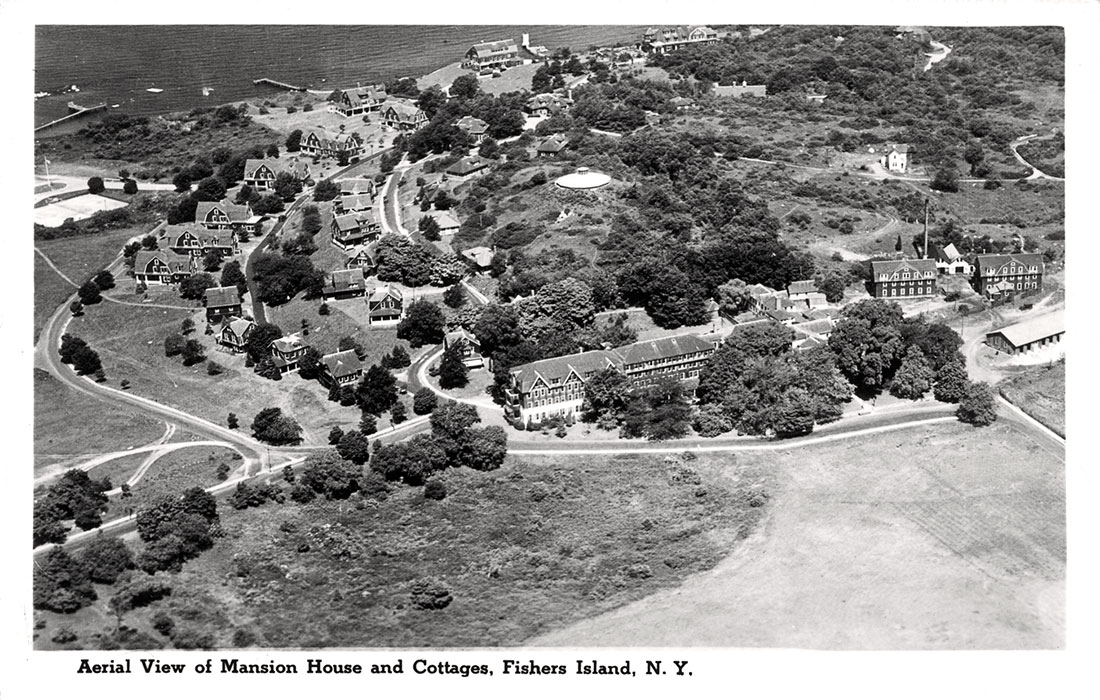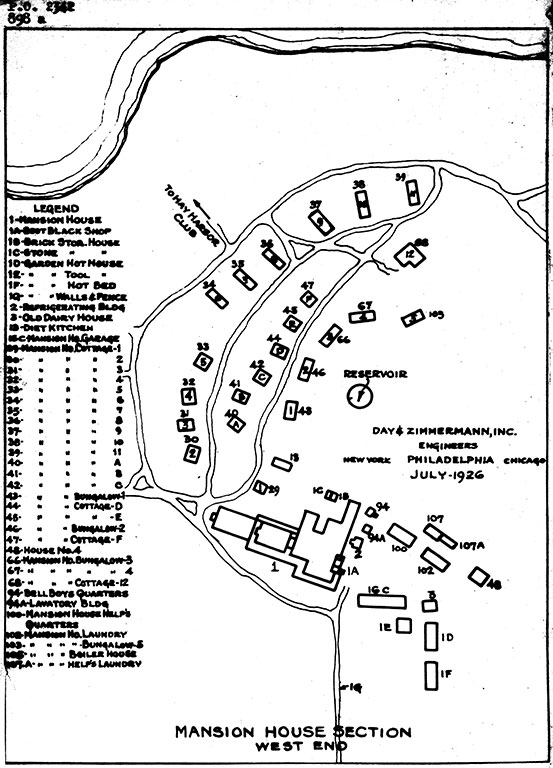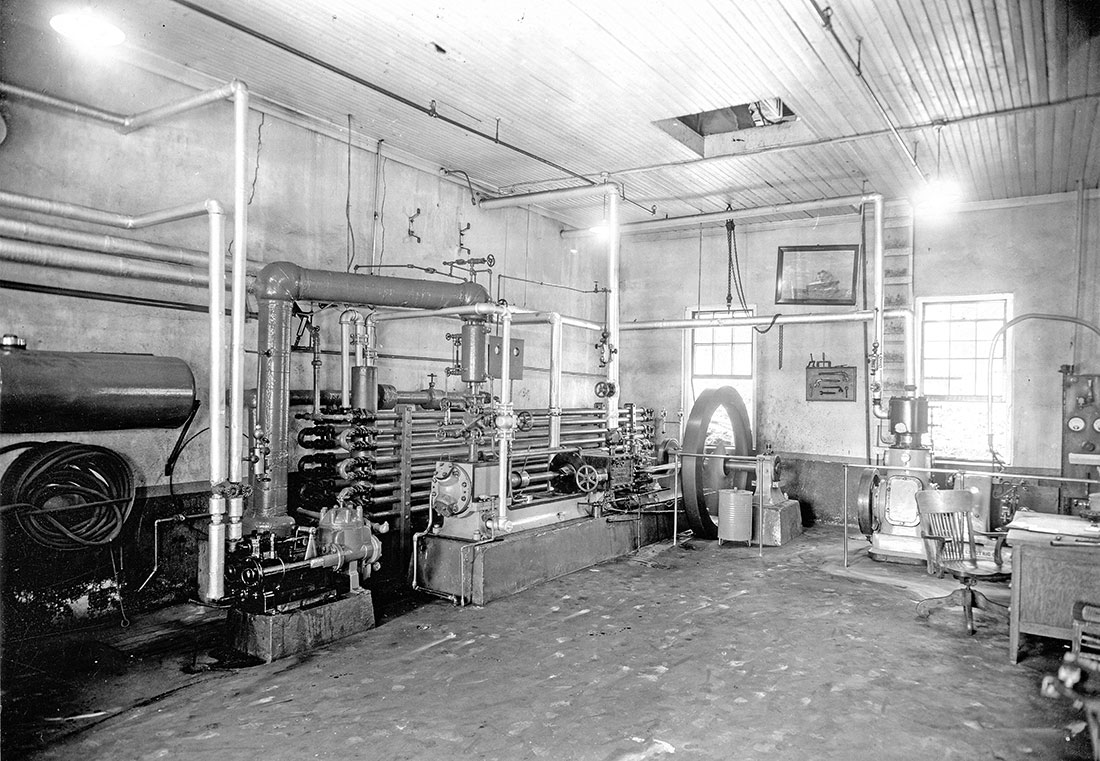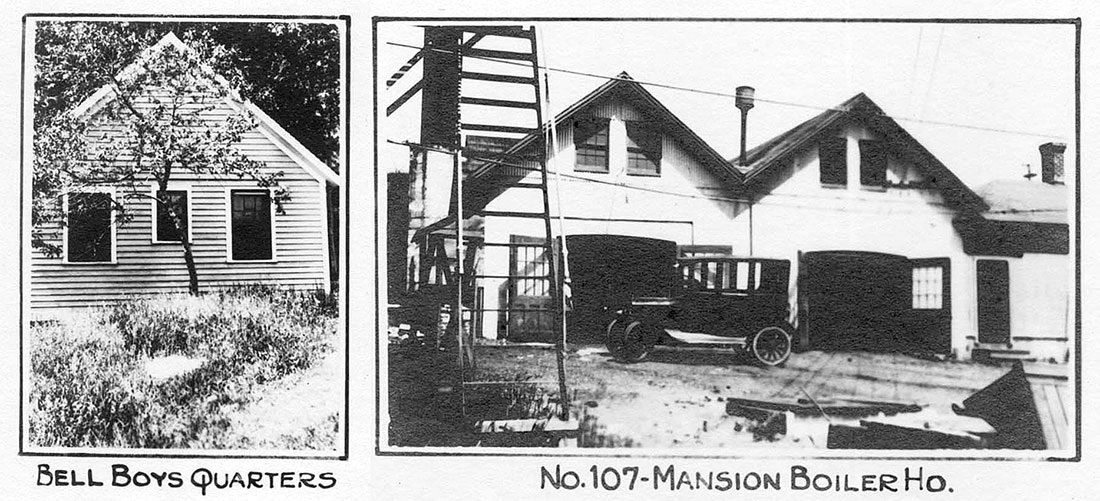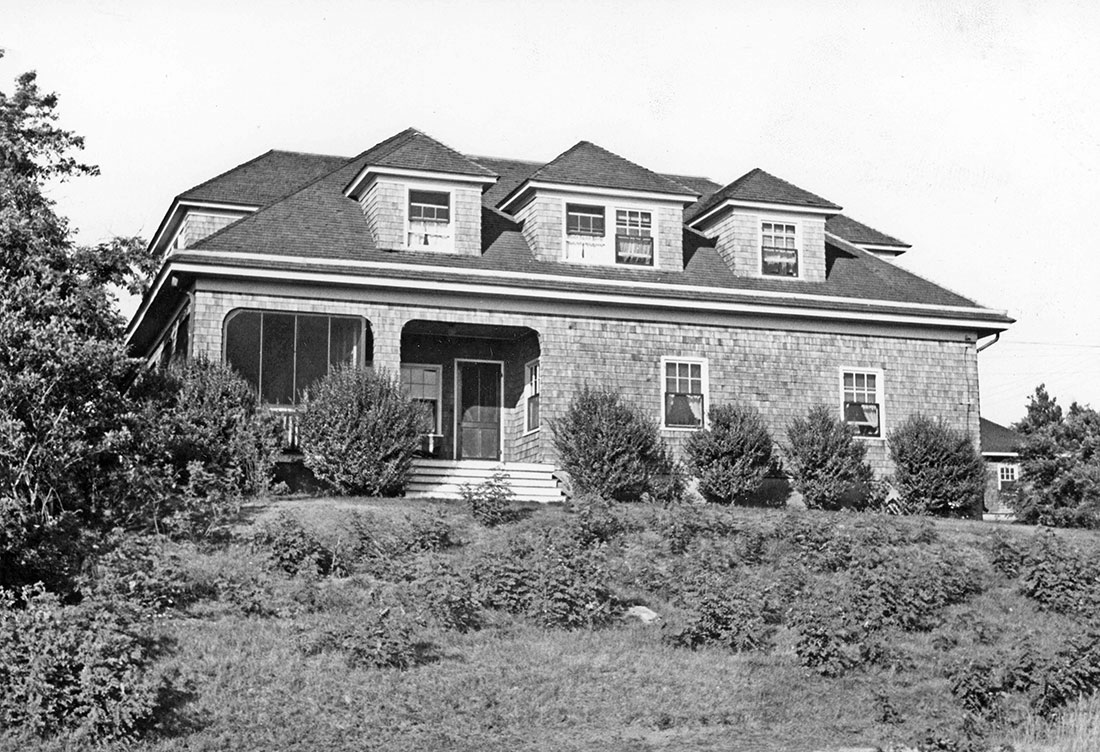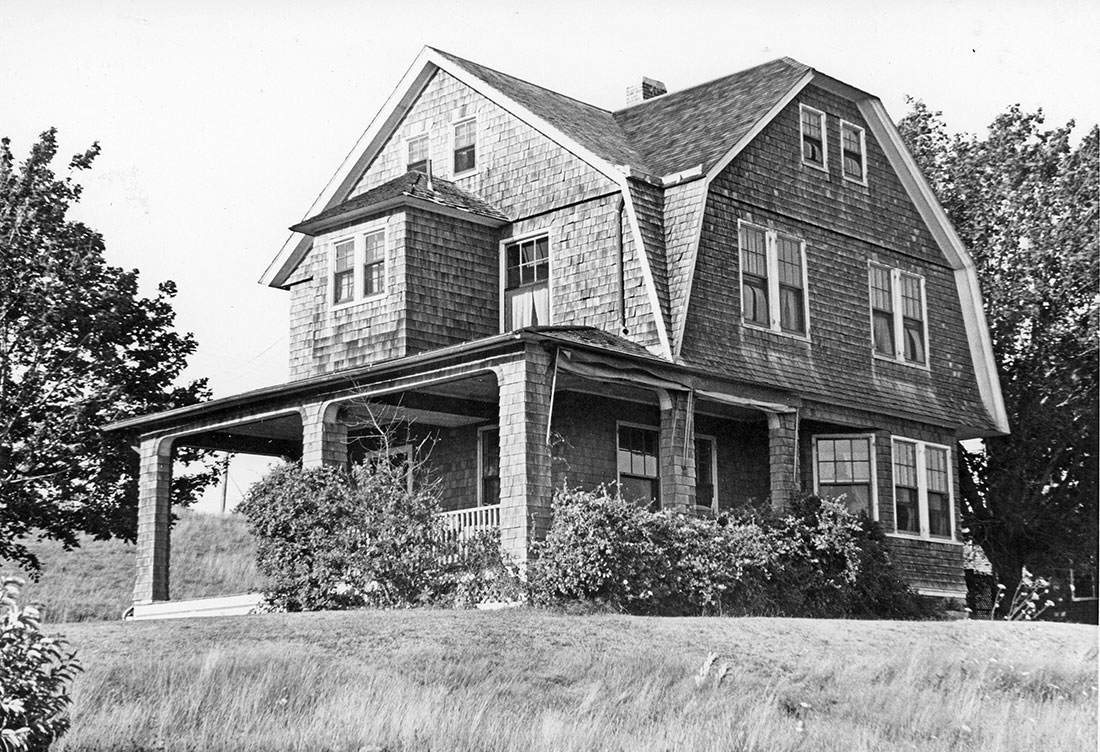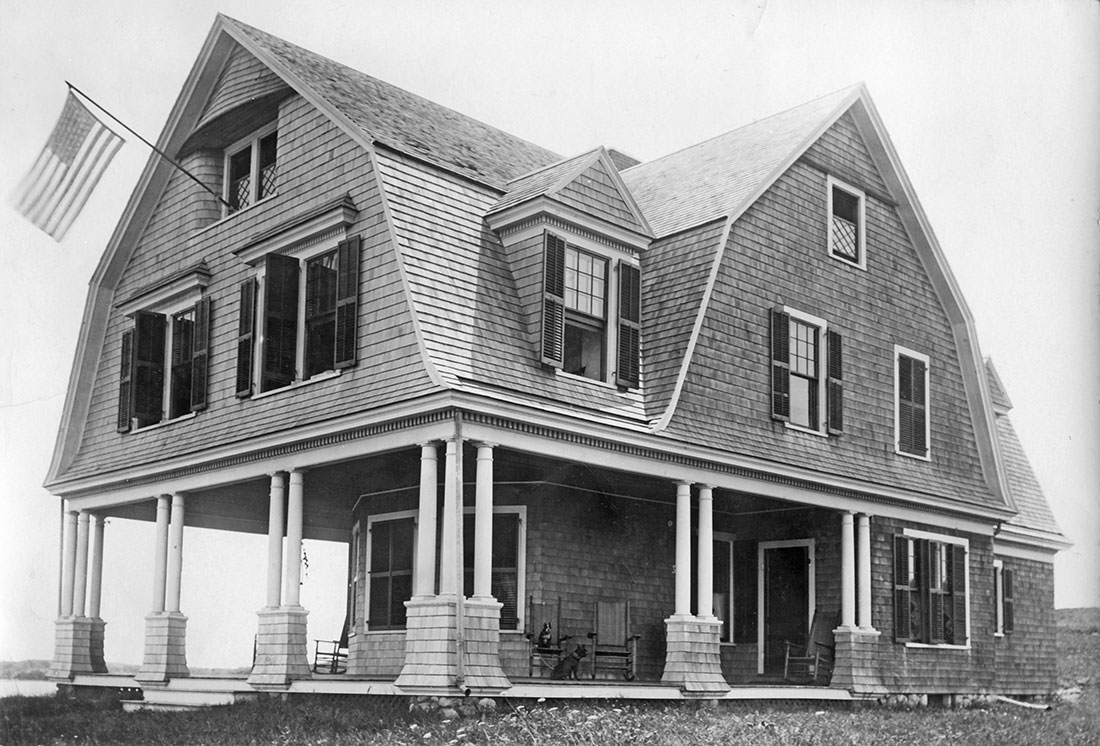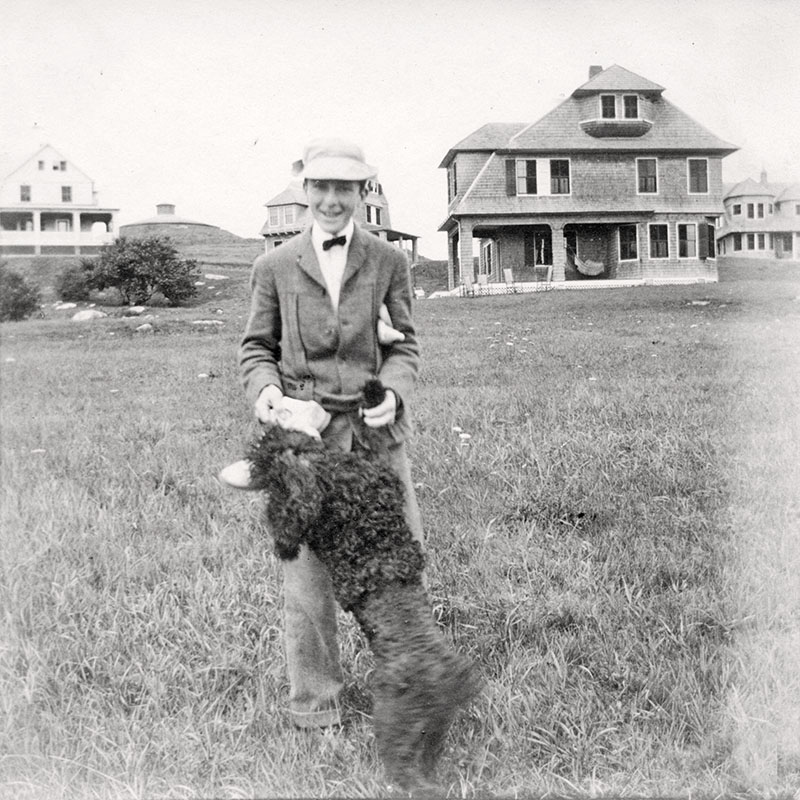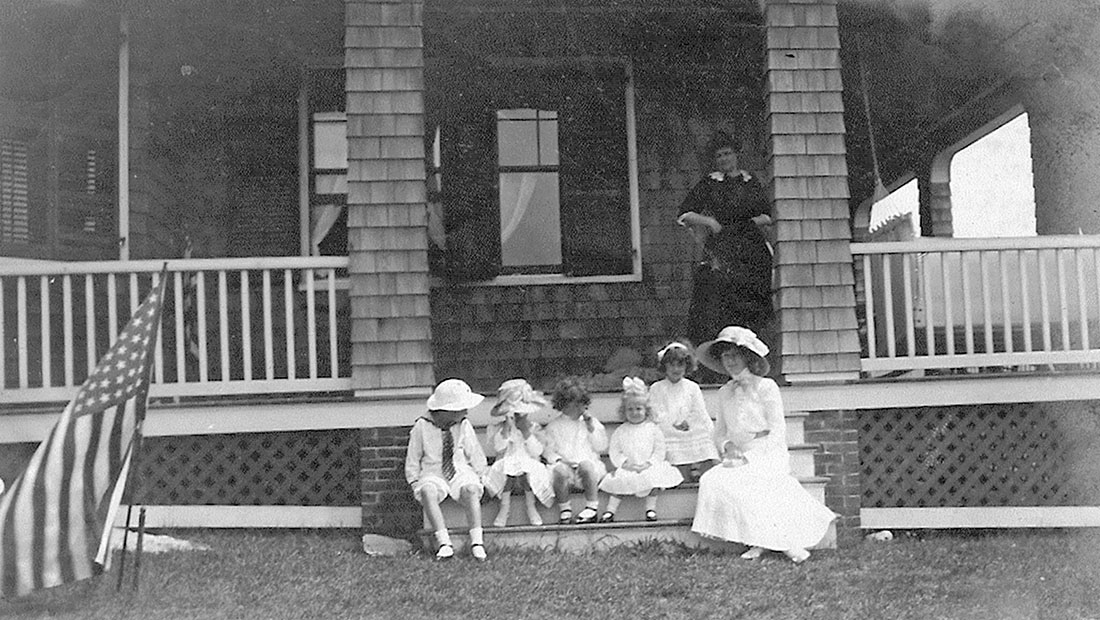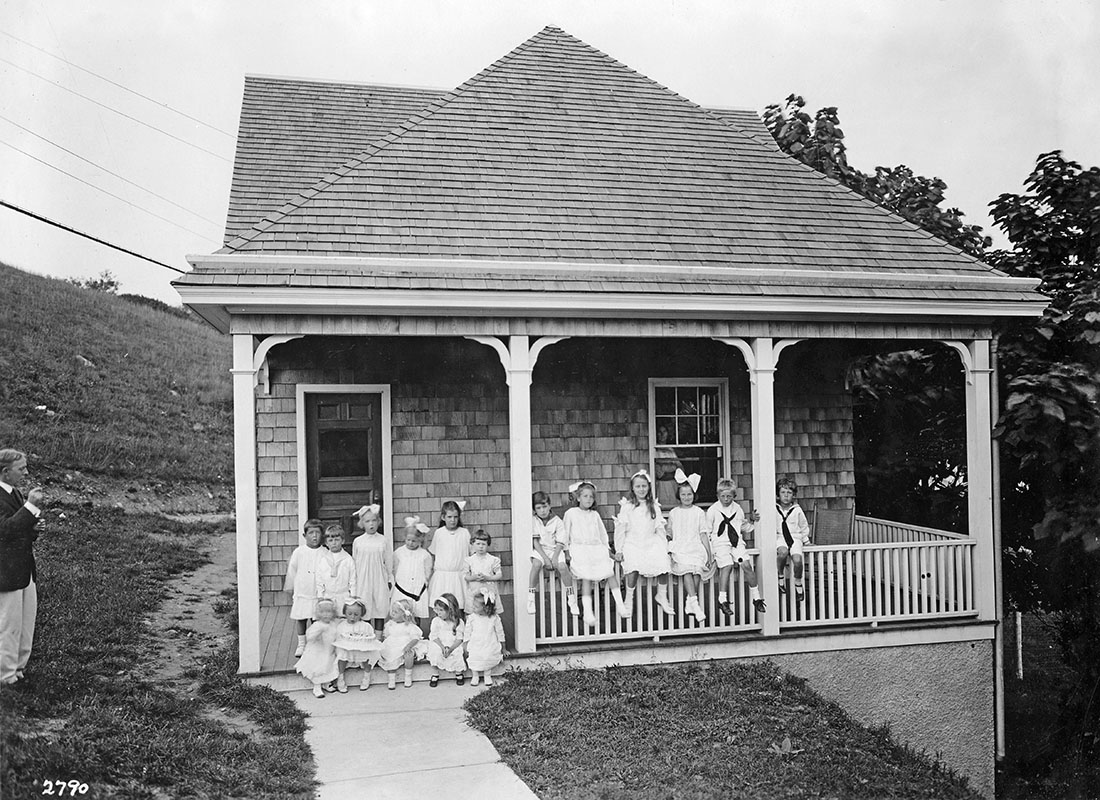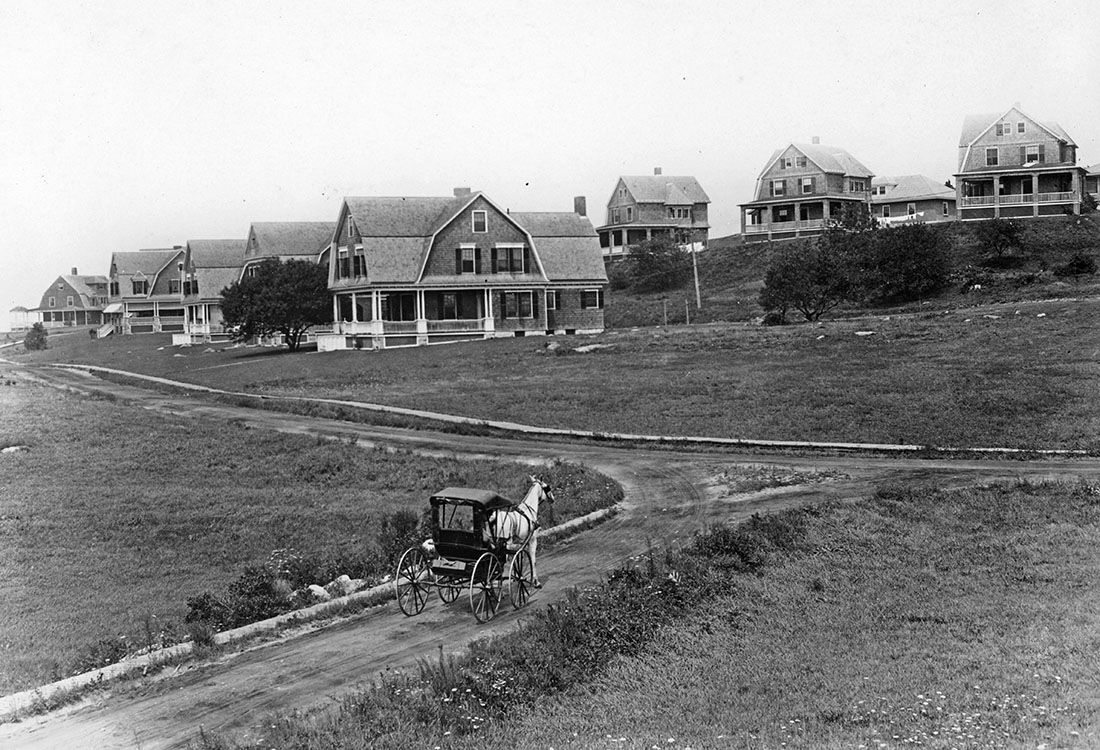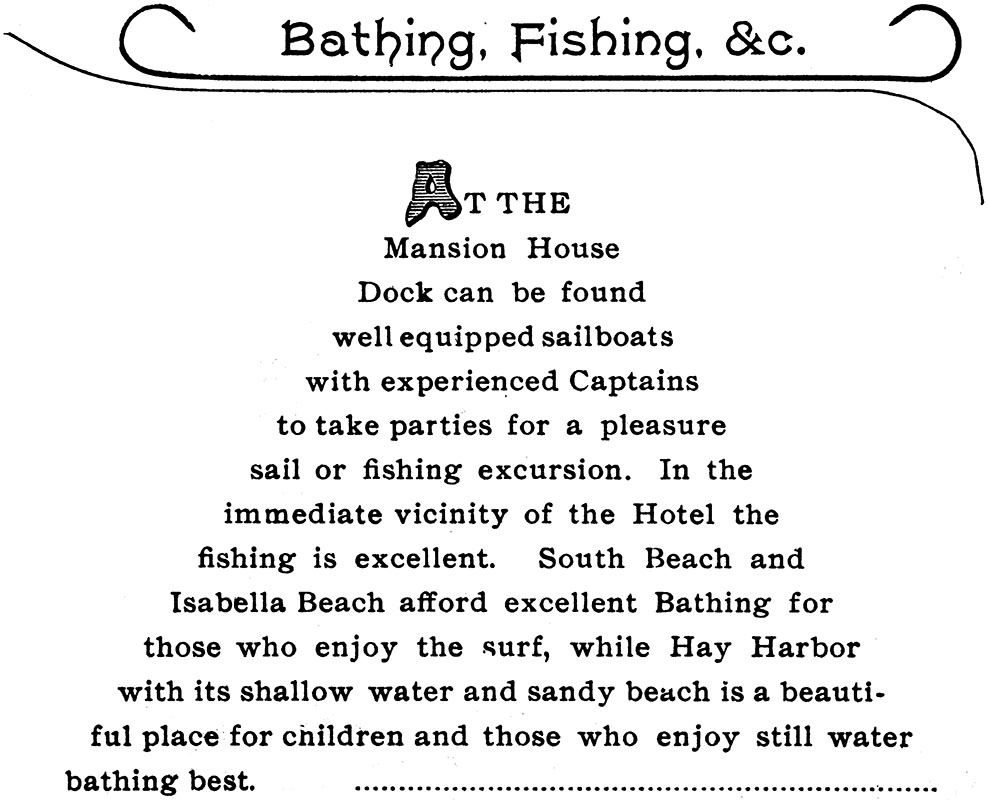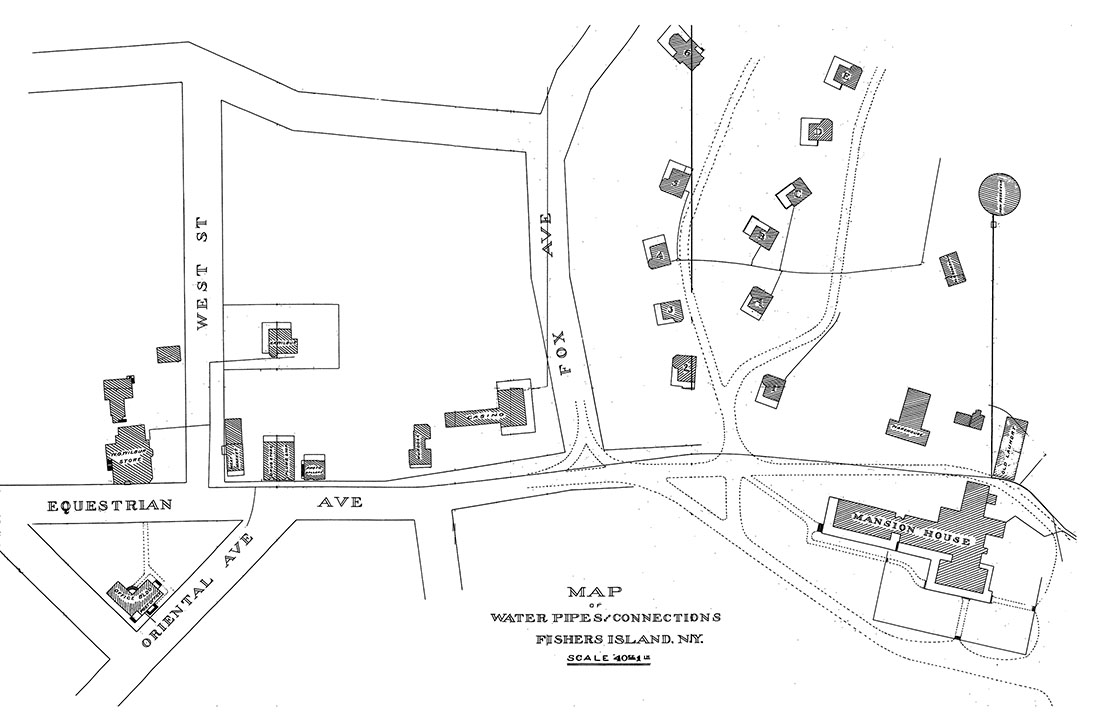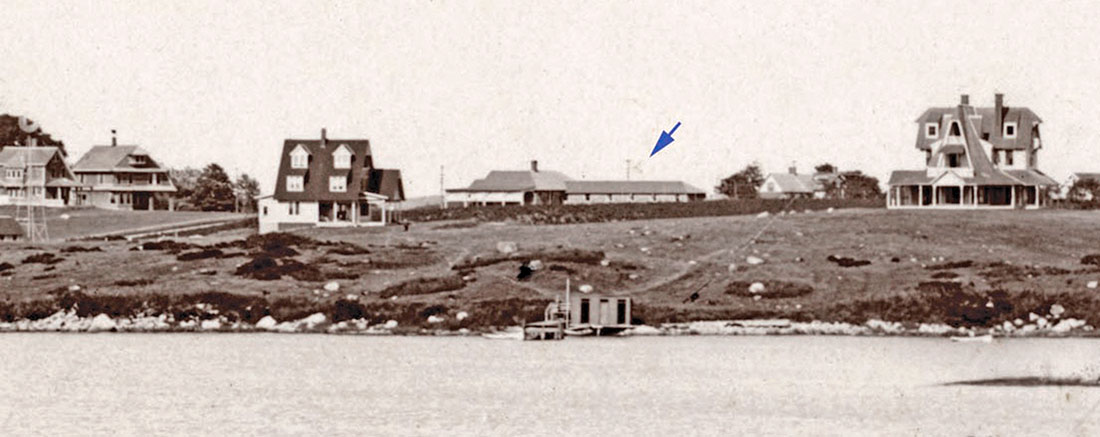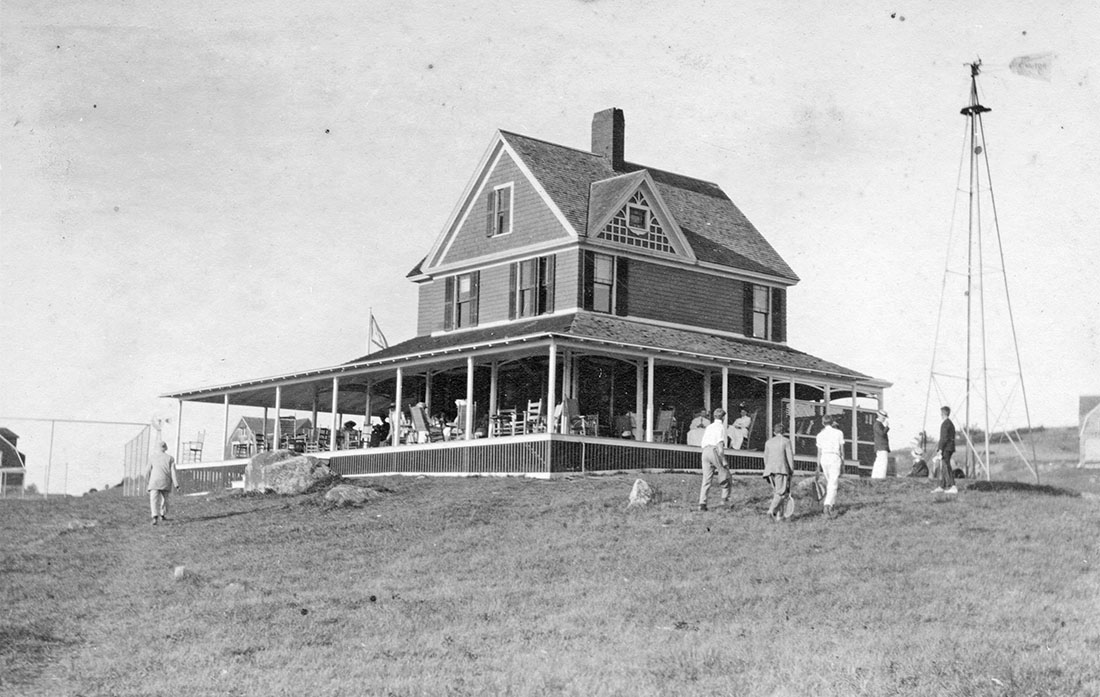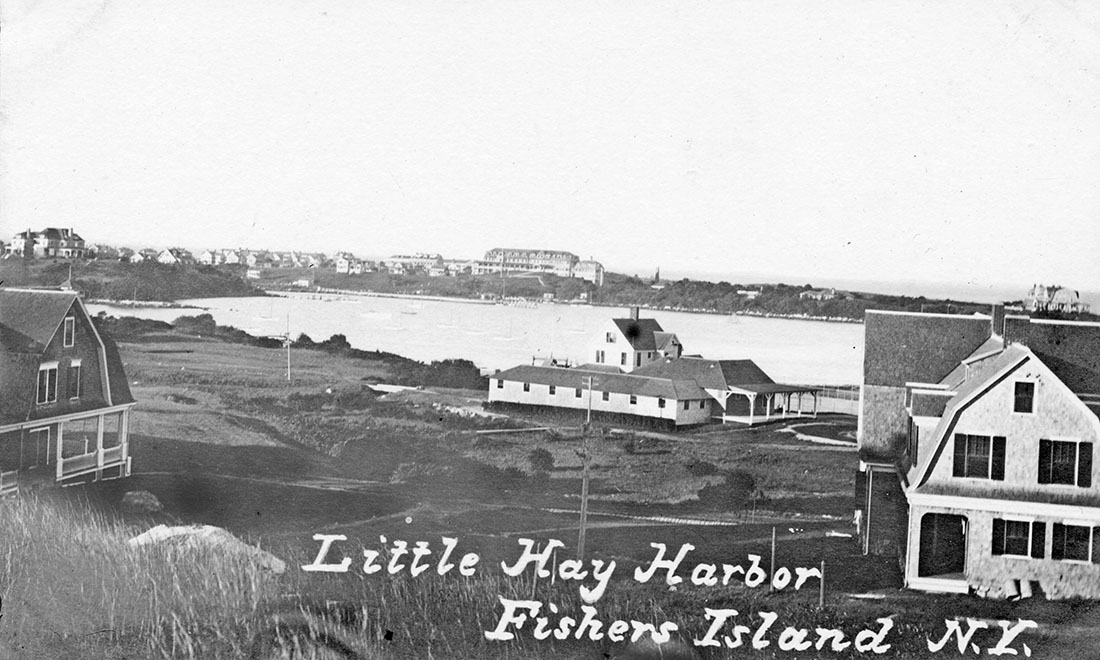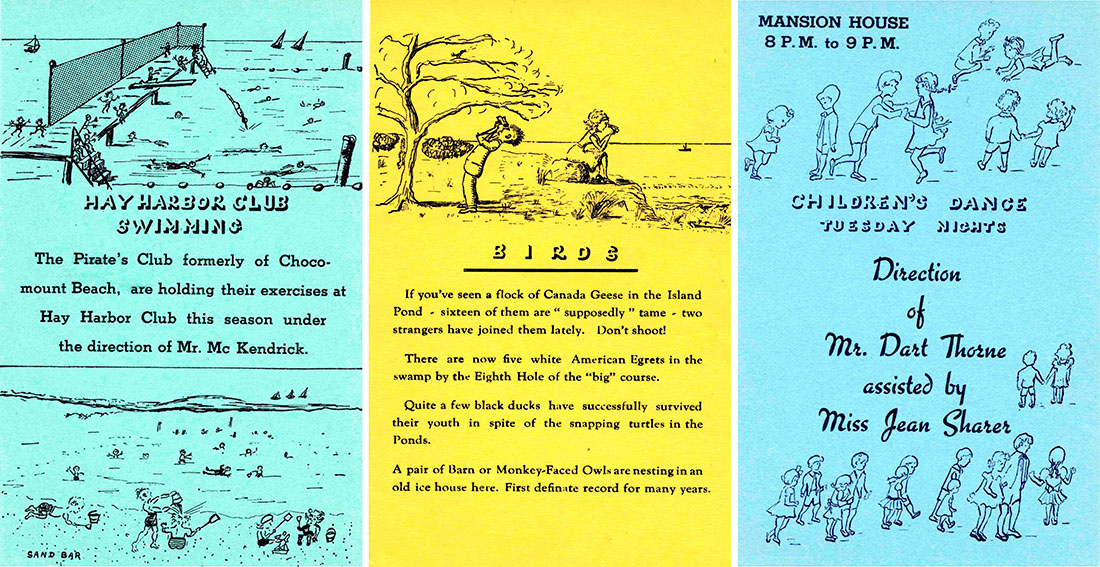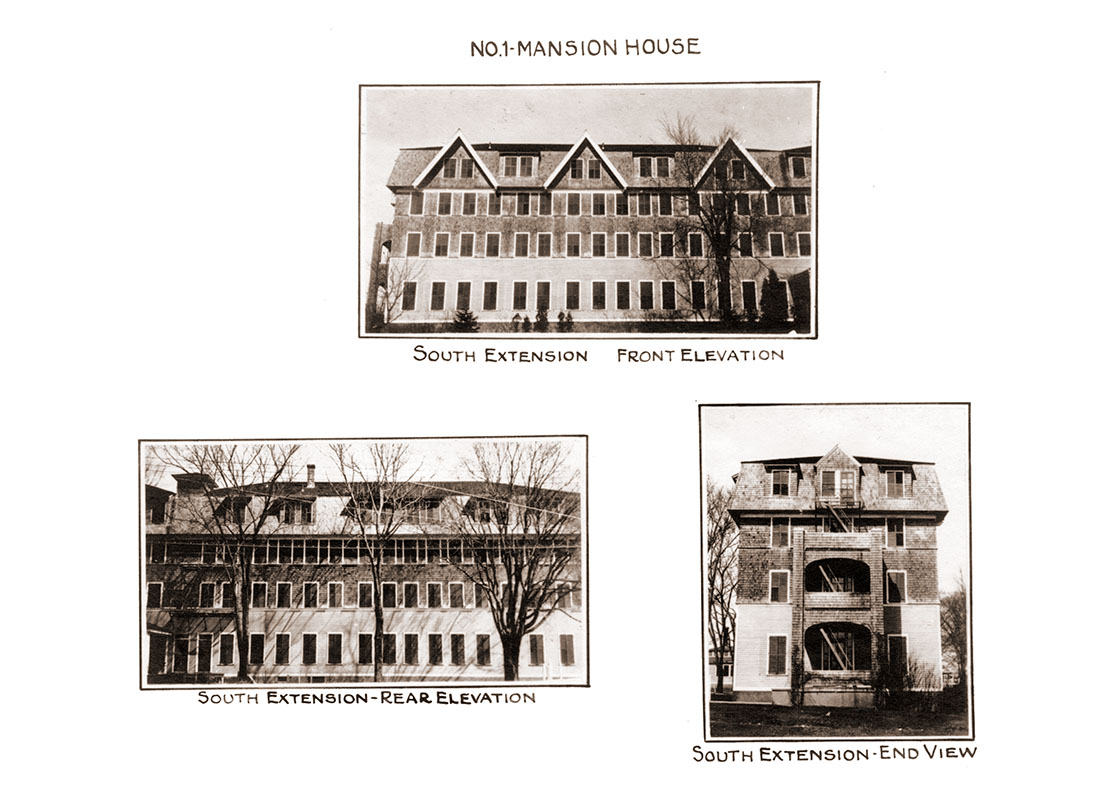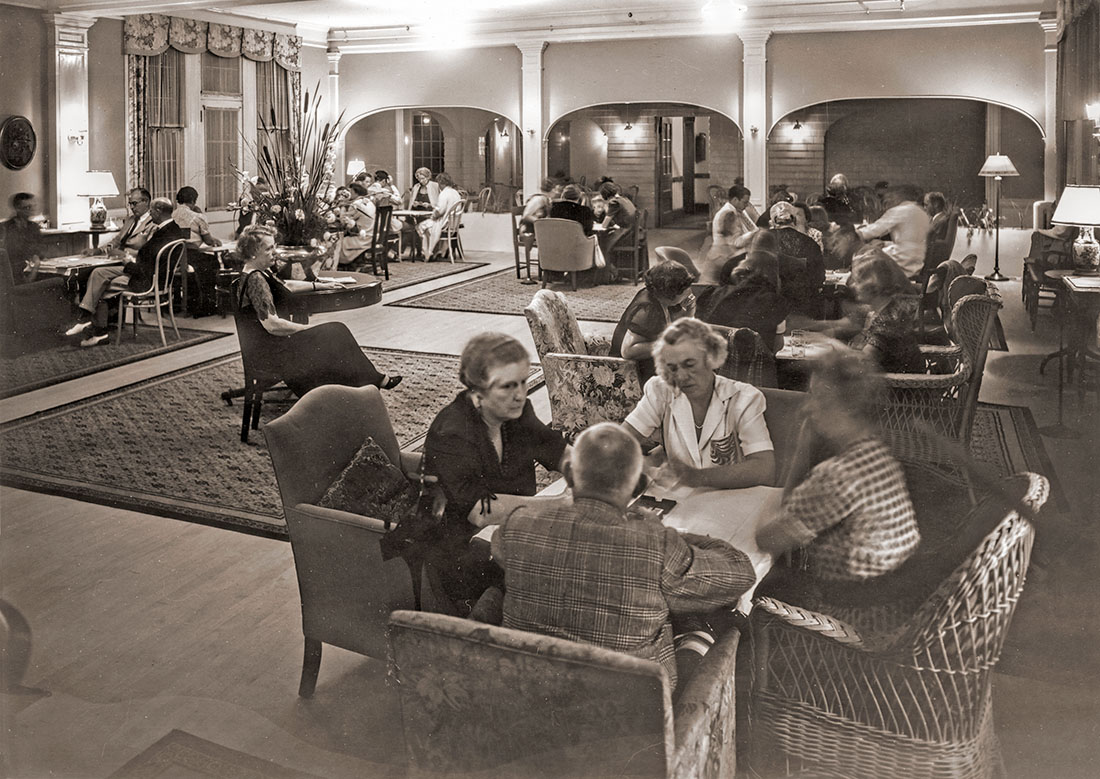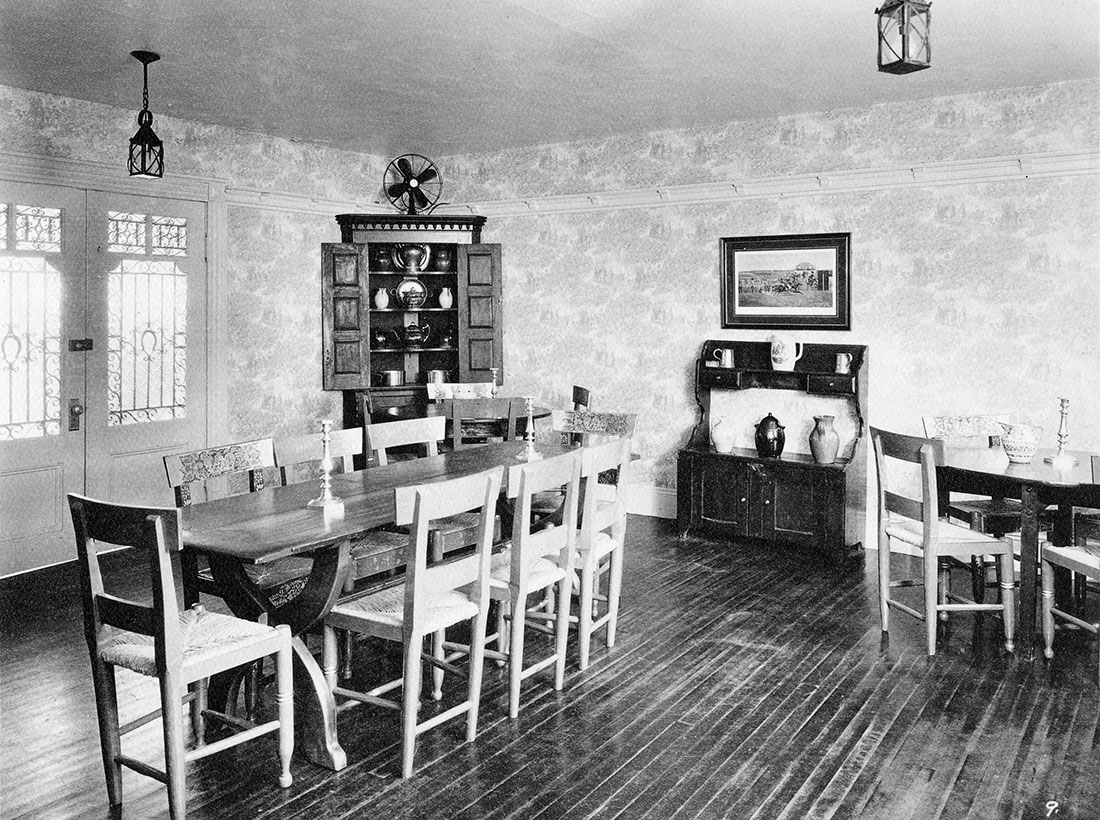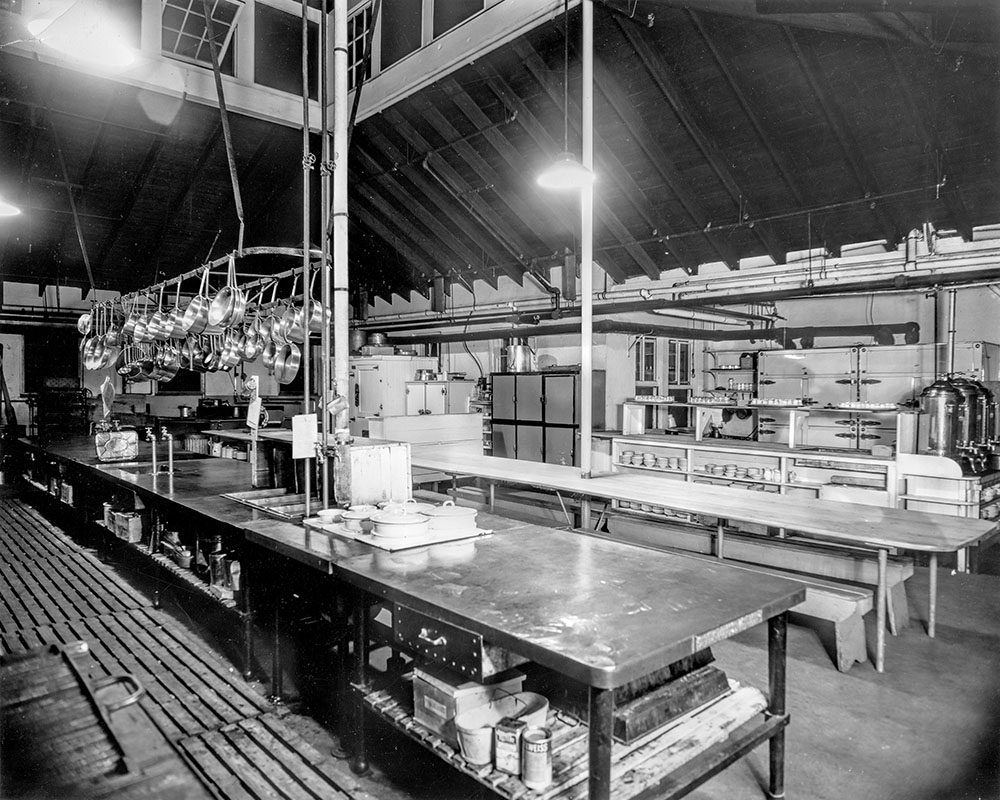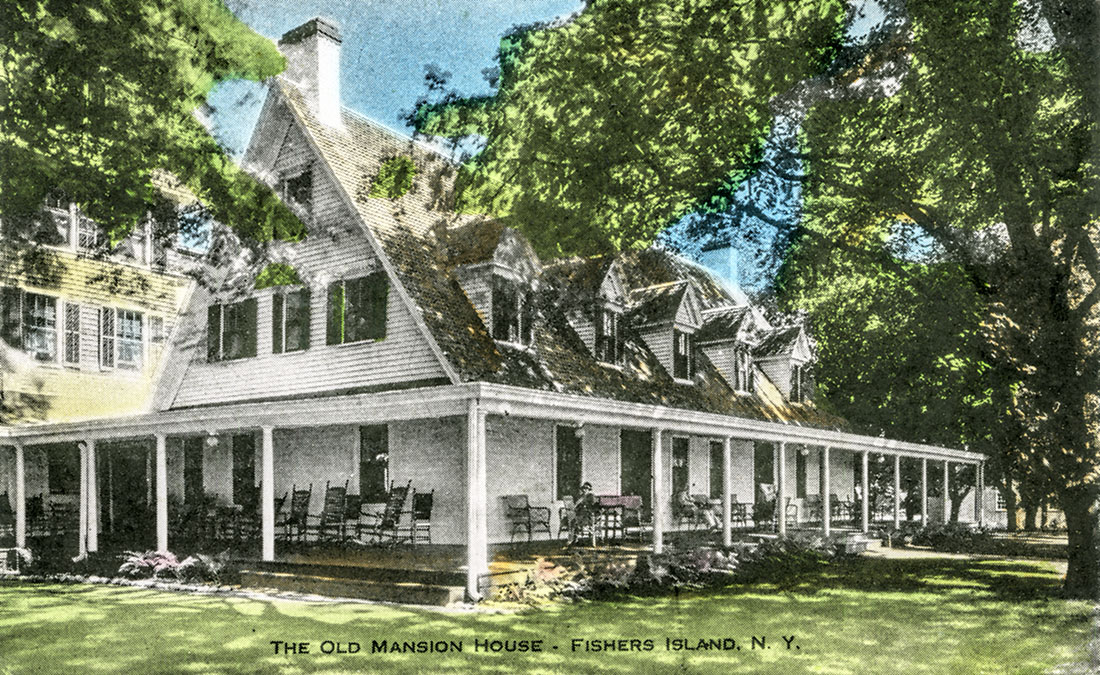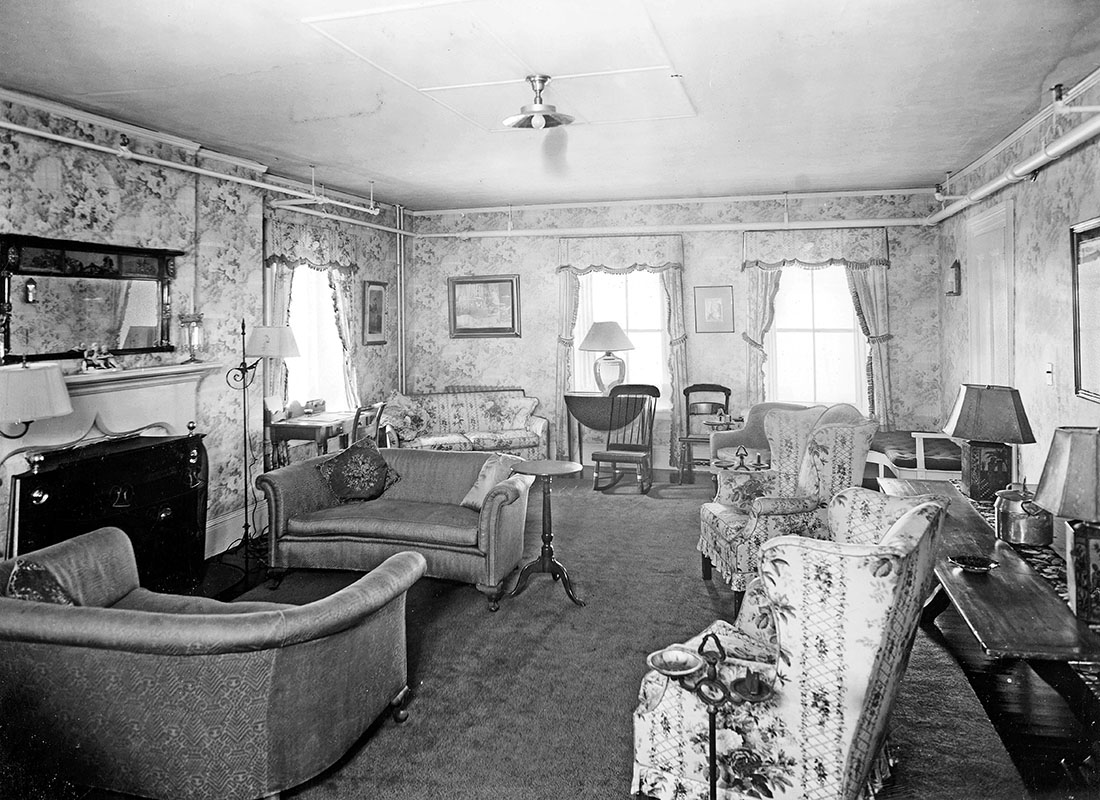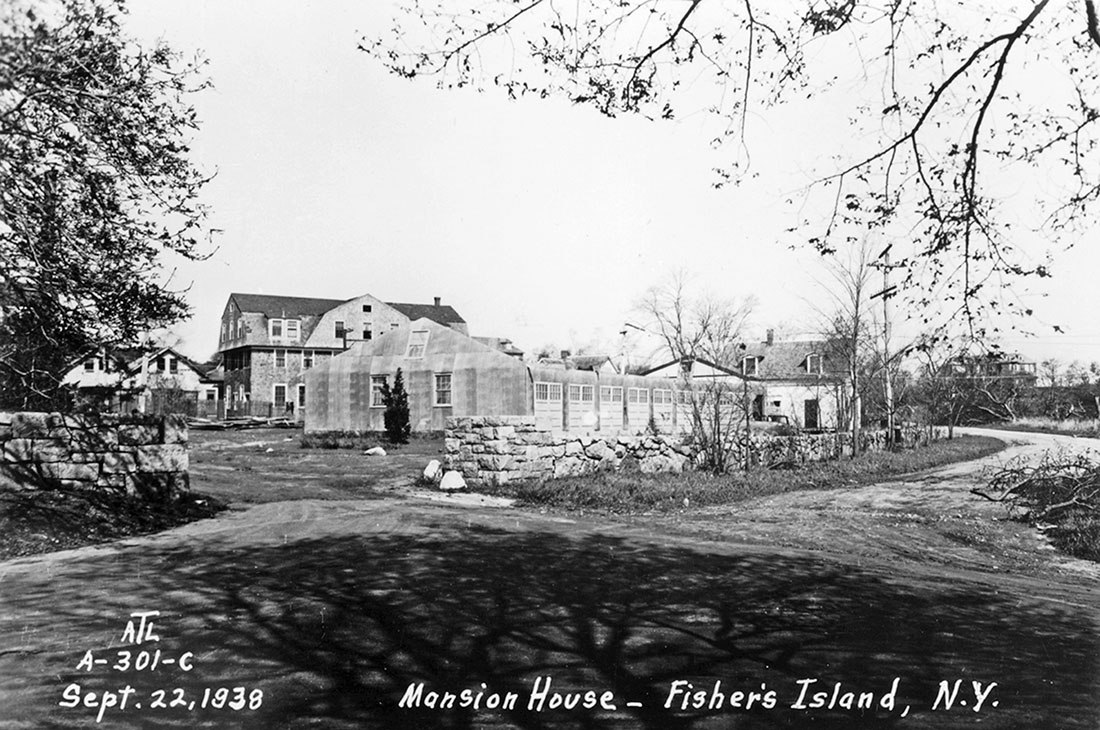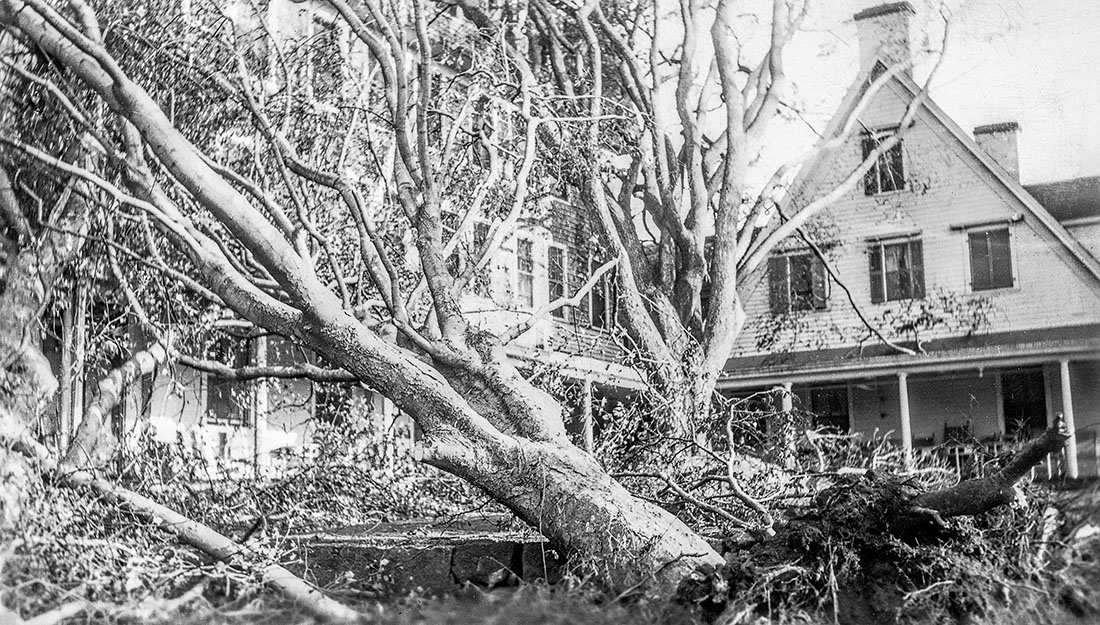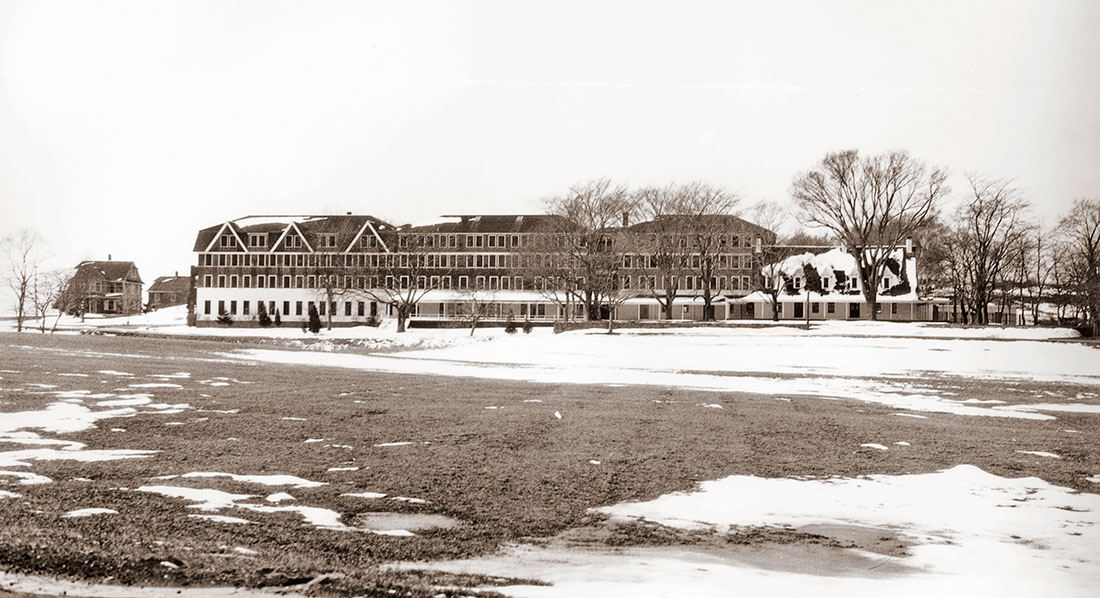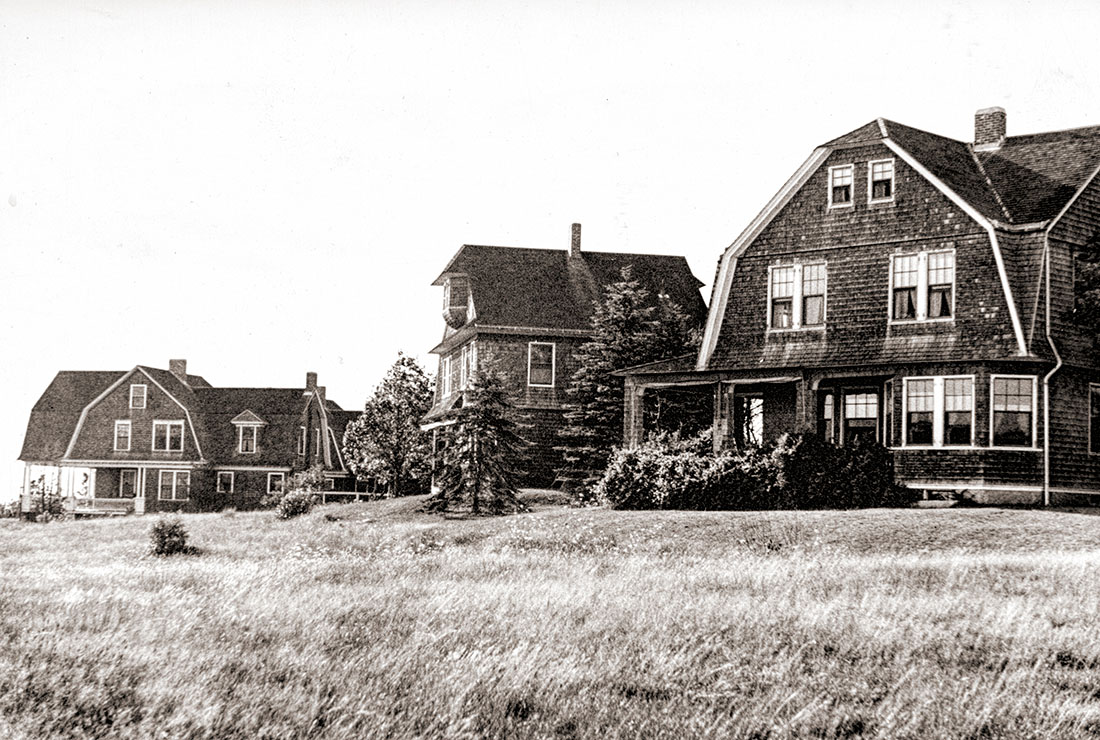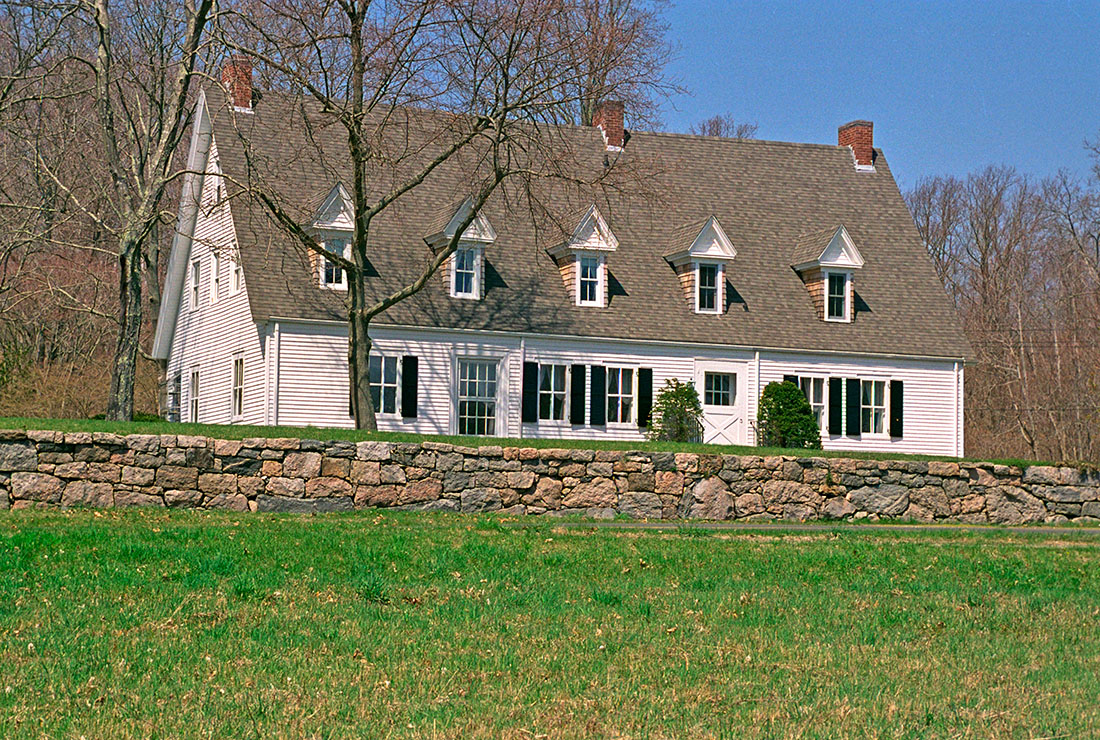The 2016 exhibition chronicled the rise and fall of the Mansion House, the premier hotel on Fishers Island during the late 19th and early 20th centuries.
The Mansion House has a storied history stretching back to the Revolutionary War. It was first built in 1780 as a Winthrop caretaker’s cottage following the torching of all the Island’s houses during a British raid. For the next eight decades, this replacement cottage was occupied by a succession of tenant farmers and farm managers hired by the island-owning Winthrop family. In 1863, Robert R. Fox, a retired merchant, purchased all of Fishers Island from the last of its Winthrop owners. He promptly transformed the relatively humble farm cottage into an elegant private residence more befitting his status as island owner. (The name “Fox Mansion House” was first used during this period.) In the wake of Mr. Fox’s death in 1871, his widow and the Fox estate’s executors endeavored to sell or lease Fishers Island while also promoting the potential of the Mansion House as a hotel. In 1876, with no buyers or lessors in sight, the Fox estate began offering land lots for sale to the public, the first such sales since the founding settlement in the 1640s. They then opened the Mansion House for the summer season of 1877 as Fishers Island’s first destination hotel. Soon small steamers were bringing boatloads of visitors from the mainland. This was the beginning of the hotel era on Fishers Island.
Detail from map depicting the Pequot River and Fisher’s Island
Drawn by Ezra Stiles
January 29, 1762
Courtesy of Beinecke Rare Book and Manuscript Library, Yale University
The text of the map’s legend is as follows:
Fisher’s I. 7 Miles Long
A. The Harbor on the No[rth] side
B. The only house on the Island
C. Excellent cleared land
This Island under Jurisd[iction] of New York and pays taxes there. It has 50 Deer upon it.
Please note that “B” marks a house that was later torched by the British during a Revolutionary War raid. In 1780, the Winthrop owners built a replacement house on or near that location that became known as the “West House.”
Detail from chart “FISHERS ISLAND SOUND – CONNECTICUT”
First published in 1877 by US Coast Survey with Aids to Navigation corrected to 1885
Courtesy of University of Connecticut, Map and Geographic Information Center
In 1863, a wealthy retired merchant named Robert Fox bought all of Fishers Island from the last in a long line of Winthrop owners. He chose to make the West House, marked prominently on this map, his primary residence, envisioning it as the center from which he would restore Fishers Island as a great stock farm.
The West House had been built in 1780 by the Winthrops to replace a house that the British had torched during a Revolutionary War raid. Prior to Mr. Fox’s purchase, the West House, a simple brick structure, had typically been occupied by the primary lessee of the island, or, when there was no lessee, by a hired Winthrop caretaker.
An early view of the Fox Mansion House
Circa late 1870s
Museum Collection
Before moving in with his family and household servants, Mr. Fox transformed the West House into an elegant residence more befitting his status as owner of Fishers Island. Post renovation and expansion, the much improved West House soon became known as the Fox Mansion House.
The Fox Mansion House showing rear addition and adjacent farm buildings
Circa 1880s
Museum Collection
After Mr. Fox died in 1871, Mrs. Eliza Fox, his widow, working with the Fox estate executors, began to promote potential uses of the Fox Mansion House. Their goal was to attract buyers or lessees.
In the mid-1870s, the island-owning Fox family pivoted away from running an animal stock farm to a new focus on making Fishers Island a destination for human visitors. During this period, the island’s cows and sheep took a back seat to people for the first time since European settlement in the 1640s. The Mansion House played a central role in this transition to a human centric island.
In 1872, the Fox estate placed an advertisement in The New York Times that stressed Fishers Island’s potential as a single or divided farm, and as a site worthy of attention from yachtsmen and sportsmen.
The ad also touted the Mansion House as being “large and roomy, and with the adjacent buildings, can be readily fitted to accommodate one or two hundred boarders.” When no lessees or purchasers stepped forward, Mrs. Fox continued to take on small numbers of boarders at the Mansion House, but did not immediately revisit the notion of opening an establishment capable of housing and feeding hundreds of guests.
After several years of operating as a local boarding house, the Mansion House opened its doors as a destination hotel on July 1, 1877. Land sales to the outside world had begun several months before and a small winter and summer community was already beginning to take shape on Fishers Island.
The New London-based Pequot & Ocean Transit Company, working in coordination with the Mansion House, immediately began carrying passengers from the mainland to and from Fishers Island on their Steamer Cygnet. This was the first regularly scheduled ferry service to Fishers Island. On most days, the Transit Company ran three boats a day. These trips continued straight through the summer season.
“Map of Lots on Fishers Island, Embracing the Highland Range between the Great Harbor and Atlantic Shore”
Surveyed and Mapped by E.B. Jennings, New London, May 1, 1878
Traced 1919 by D.S. Trowbridge
Museum Collection. Reproduction donated by Katherine Arnold
Land sales to the public began on Fishers Island in 1876 with all sales restricted to the west end. Allowed to take root, a small New England community sprang up almost instantly. By the end of the 1880s, Fishers Island had its first church, its first school, several hotels and boarding houses, a steamboat line, two rental cottage clusters, and a newly established population of winter and summer residents that was rapidly expanding.
“Time Card Steamer Cygnet – New London and Fishers Island”
1877
Museum Collection. Acquisition
The Mansion House offered lodging and dinners to guests and boarders, and shore dinners and clambakes for those wishing less formal fare. There was even a proprietor named Professor De la Vergne, whose very name added a touch of class to the new establishment.
Side-angle view of the Mansion House
1887
Museum Collection. Donated by Polly Edmonds
This side view of the Mansion House reveals the full sweep of the rear addition and shows the size of the hotel during the period of its Fox-family ownership, 1877 to 1889.
Fishers Island’s first post office was located at the back of the addition, just to the right of the rear porch pillars. Please note the sports net at right that was likely used by guests for badminton, or another net game.
By 1882, the new resort featured a second major hotel, the Lyles Beach. During the season, this hotel attracted countless excursionists (“daytrippers”) who arrived on large excursion steamers.
Advertisement for the Grand Opening of the Lyles Beach Hotel, Fishers Island, NY
July 1, 1882
Museum Collection
Opened in 1882 as a destination “shore hotel” for excursionists, the Lyles Beach offered a variety of inducements that attracted large crowds of yesteryear’s “day trippers.” It was owned by businessmen associated with Norwich, Conn.
The range of activities included swimming, sailing, dancing, bowling, billiards, arcade games, baseball, and a shooting range “better than the military.” Drinking was also a primary attraction, as some sections of southeastern Connecticut were then “dry.”
Unfortunately, there was rain on opening day and the crowds were quite minimal.
Lyles Beach Hotel, Fishers Island, NY
Circa 1891
Museum Collection
Billed as “The Coney Island of the East,” the Lyles Beach Hotel was Fishers Island’s first major hotel. It was located on the island’s north shore several hundred yards west of the entrance to West Harbor. On weekends hundreds of “day trippers” arrived for a day of fun, and almost always left by day’s end.
Familiar with Fishers Island from visitations beginning in the mid-1880s, two brothers named Edmund M. & Walton Ferguson, both prominent bankers and businessmen, bought nine-tenths of Fishers Island in 1889 from the Fox heirs, the exceptions being the 101 parcels that had been sold by the Fox family between 1876 and 1889.
Their plan for development was ambitious: transform Fishers Island from a day excursion destination to a seasonal resort that catered to an exclusive clientele.
Over the next 15 years the two Ferguson brothers invested heavily to create an infrastructure worthy of a first class resort. They established a new electric company, a water system with a mid-island pumping station, a private navigation company, a golf club, and numerous other businesses.
Edmund M. and Walton Ferguson. Dates unknown. Museum Collection
The two Ferguson brothers operated under the business name: “E.M. & W. Ferguson.”
The two existing Fishers Island hotels at the time of their purchase—the Lyles Beach and the Mansion House—were both important components of their development plan. They immediately expanded and improved the Mansion House and began building an associated cottage colony on Bell Hill (today’s Shingle Hill). They also bought out the tourist hotel, the Lyles Beach, which after renovations was reopened as the Munnatawket Hotel. A third major hotel, the Mononotto Inn, opened in 1893 on a bluff overlooking Hay Harbor. This hotel, owned by business parties from Bethlehem, Penn., directly competed with the Fergusons’ two hotels. By the late 1910s, these three hotels cumulatively offered more than 300 rooms to let, not including their 31 associated cottages.
Detail from illustration showing The Lyles Beach Hotel, north shore of Fishers Island, NY (west of West Harbor)
Published in New York Illustrated Times, August 9, 1884
Museum Collection. Donated by Kiki Arnold
After their major land purchase in 1889, the Ferguson brothers made it a priority to buy out and shut down the Lyles Beach shore hotel in order to stem the tide of “day excursionists” that were then flooding the island in the summer season.
Munnatawket Hotel (formerly Lyles Beach)
Circa 1893
Museum Collection. Photo by James S. Casey
After wooing the owners of the Lyles Beach for two years, the Fergusons succeeded in purchasing the hotel in 1891 for $10,000. They immediately shut it down for a complete renovation. With all major docks and landings under their control, they promptly banned all excursion steamers from landing on Fishers Island. Consequently, 1891 marks the end of the very brief tourist period on Fishers Island that lasted only from 1876, the beginning of land sales, to 1891.
The former Lyles Beach reopened in 1892 as the more elegant Munnatawket Hotel. The main hotel had 79 guest rooms with an additional 14 in the detached annex, for a total of 93.
Mansion House, Bell Hill and Little Hay Harbor, Fishers Island, NY
Illustrations from The New York Herald
July 1891
Museum Collection. Acquisition
At the time of the Ferguson purchase, the Mansion House was still a rustic “B&B” style hotel. Neighboring Bell Hill—or Shingle Hill as it’s generally called today—was almost totally undeveloped. Only two years after their purchase, E.M. & W. Ferguson began the first of several ambitious expansions of the Mansion House Hotel and simultaneously began construction of a series of associated cottages on the sides of Bell Hill.
The first six Mansion House Cottages
Circa 1893
Photograph from a promotional brochure
Courtesy of Jim Diaz
Understanding the importance of providing houses where families could stay for the entire season, the Fergusons wasted no time in erecting Mansion House Cottages on Bell Hill. The first six were completed by late 1891. As more cottages were built, more families returned year after year, often to the same cottage. As intended, they bonded to each other and to the island. The Mansion House cottagers formed a core group at the center of the early resort and, in later years, the core of the associated clubs. Ultimately, many built their own homes on Fishers Island.
“THE MANSION HOUSE AND COTTAGES” illustration from “An Island of Homes”
1897
Lithographic advertising brochure Published by E.M. & W. Ferguson
Museum Collection
Despite the Munnatawket Hotel’s superior water view, the Fergusons made the landlocked Mansion House the center of their resort. This contradiction is best explained by the fact that Bell Hill offered a prominent and varied setting for adjacent Mansion House Cottages with plenty of room for expansion.
The Mansion House and its first addition
Circa 1893
Photograph from promotional brochure
Courtesy of Jim Diaz
In 1891, the Fergusons hired H. Edwards-Ficken (1844-1929), a prominent English-born architect based in New York, to design the first side addition to the Mansion House. Completed in late 1891 or early 1892, his elegant and proportional Queen Anne-style extension didn’t last long. Before the decade was out, it was eclipsed and then replaced by much larger, more ungainly additions.
Please note that Edwards-Ficken was also the architect responsible for the Walton Ferguson residence on Fishers Island, completed 1894 (today Warden) and E.M. & W. Ferguson’s Administration Building, completed in 1898 (today’s Fishers Island Utility Co. building).
His diverse commissions in the wider world included the Cloisters building at Yale and the original 1,000-foot iron pier at Coney Island. A celebrated athlete, he also designed the winged-foot symbol of the New York Athletic Club.
Floor plan showing ground floor layout of the Mansion House and its first addition
Circa 1893
Published in promotional brochure
Museum Collection
The first addition stretched from the middle of the Fox rear addition and was known as the “Dining Room extension” because of its ground floor function. The original Mansion House residence, seen at front right in this floor plan, functioned as a front office for the hotel with an adjacent waiting parlor.
There were 33 hotel rooms on the second and third floors during this period.
Newly Constructed “Non Housekeeping” Mansion House Cottages
Circa 1901
Museum Collection. Donated by Harry and Susie Ferguson
Many early Mansion House Cottages lacked a full kitchen and were designated “Non Housekeeping.” They did have a small range for heating water for the bath. Not to worry! The absence of a kitchen was promoted as a positive: cottage renters could eat and socialize at the hotel, or, if so desired, have meals delivered straight to their cottages. Guests were assured in promotional brochures that they could be “at home” without any of the cares or worries of actual housekeeping. Porters and bellboys were just a buzzer or a phone call away. In fact, the cottages were so convenient that household servants were not even needed.
For those who wanted full kitchens, “House Keeping” cottages were also constructed and offered for seasonal rental.
Horse and buggy passing Mansion House Cottages
Circa 1913
Photograph by Brown & Dawson, Stamford, Conn.
Museum Collection. Donated by Harry and Susie Ferguson
The front row of Mansion House Cottages had filled in by the early 1900s. The cottages pictured here are (from R to L): Cottage #6 through Cottage #9.
At far left is the William E. Stone residence (today Maysles). Built in 1888, it was the first house in this area, preceding the adjacent Corson Cottage (circa 1891), two neighboring Ferguson residences (both built in the mid-1890s) and the Mansion House Cottages (built between 1891 and the mid-1910s).
“Mansion House Cottages, Fishers Island, N.Y.”
Circa 1910
Printed color postcard
Museum Collection. Donated by Pierce Rafferty
Please note the protuberance on the top of Bell Hill. This was the roof cover of the reservoir for the western end of the island. The Fergusons first established a water distribution system in 1904 that included a brick pump house on Barlow Pond, a pumping main, and the reservoir seen here. The Bell Hill Reservoir had a capacity of 330,000 gallons, a diameter of 51 feet, a depth of 22 feet, and 24-inch thick brick walls. Water was gravity fed from its tank that stood at the highest spot on the west end.
The Bell Hill Reservoir was eclipsed by the “Top of the World” reservoir (500,000 gallon capacity) built in the mid-1920s on Chocomount Hill as part of the Olmsted Plan. It is still the island’s primary reservoir. Bell Hill continued to function as a secondary reservoir until its wooden roof decayed circa 1957. A residence was later built atop the former Bell Hill Reservoir site.
Mansion House dock
1893
Museum Collection. Donated by Mary Jean Pelham
Originally built by the Winthrops, this dock was much improved by Robert Fox following his purchase of Fishers Island in 1863. When the Steamer Munnatawket first made runs to Fishers Island in the early 1890s, she tied up at this dock to facilitate access to the nearby Mansion House.
The Day reported that the “venerable Mansion Dock” was torn down in late January 1914. Note that the Fishers Island Yacht Club’s dock was built in the late 1920s on or near this original Mansion House dock site.
Aerial view of the Mansion House wharves with ferry at steamer wharf
Circa 1925
Reproduction detail from aerial photograph
Museum Collection
The Mansion House wharves extended into West Harbor lining the edge of a two-acre approach comprised of fill. There were steamer and yacht wharves and a protruding 126-foot long Coal Pocket wharf. Passenger ferries arrived and departed from here on occasion beginning in the early 1900s and regularly from 1926 through 1947. Built between 1902 and 1912, the Mansion House wharves were torn down in 1959 and replaced by a less prominent dock that is used today by some of the Island’s commuter ferries and for Goose Island’s boat refueling service.
Mansion House wharf
1936
Courtesy of Maxine Arnold
Please note the freight building at left center that featured a second story “open air” waiting pavilion. This 1895 building, originally situated on the Munnatawket Hotel dock, was moved to the depicted Mansion House wharf location circa 1926. Prior to the tearing down of the Mansion House wharf in 1959, the freight building was moved ashore and converted by Gordon Ahman into a residence for his family that still stands overlooking West Harbor.
“Veranda, Mansion House, Fishers Island, N.Y.”
Circa 1915
Printed color postcard
Published by W.G. Wilbur, Fishers Island, N.Y.
Museum Collection. Donated by Pierce Rafferty
The “Dining Room extension,” a redo of the first Edwards-Ficken addition, is at left. The original Mansion House residence that served as the hotel’s office is straight ahead.
“Mansion House, Fishers Island, N.Y.”
1914
Real photo postcard
Photograph by Edward Quimby
Museum Collection. Donated by Fort H.G. Wright Association
Circa 1912, a third major extension, four stories high, was added to the Mansion House. It featured a large living, or drawing room for socializing on its ground floor. Please note how the second extension to its right still only had three floors. It would soon expand skyward with an added fourth floor.
“Aerial of Mansion House and Cottages, Fishers Island, N.Y.”
Circa 1937
Courtesy of Harry Ferguson
This birds-eye-view aerial, dating from the 1930s, provides the best single view of the entire Mansion House and Cottage complex. When the three rows of cottages were finally filled in by the mid-1910s, 24 structures ringed Bell Hill, including 18 cottages, 5 bungalows, and a Diet Kitchen that was dedicated to serving children healthy meals.
Work-related buildings can be seen at right, including Building 100, the Help’s Quarters, and the identical Building 102, the Mansion House Laundry. The neighboring low-lying structure was the Market Garden Hot House.
“Mansion House, Fishers Island, N.Y.”
Circa 1940
Real photo postcard
Photograph by Adelard T. LeGere
Museum Collection. Donated by Pierce Rafferty
This photo documents the Mansion House at its peak size with three four story extensions. The historic residence is all but lost behind the trees at right. The exact date that the first and second extensions were raised to four stories has not yet been determined.
The three extensions cumulatively stretched 273-feet to the south from the side of the rear addition of the historic residence. The third addition brought the Mansion House Hotel’s room total to more than 120, not including the Cottages.
The Mansion House typically opened in late June and shuttered by late September. After the English Springer Spaniel Trials started to be held on Fishers Island in 1924, the hotel stayed open into late October. Remarkably, at the turn of the 19h century the Fergusons briefly experimented with keeping the Mansion House open all year round!
In an article about Fishers Island published in 1903, author Henry Robinson Palmer wrote: “The visitor is surprised to find an inn of the quality of the Mansion House ready to serve the public at all seasons of the year. Who he wonders, comes to Fishers Island in mid-winter? Where is the profit in running such a hotel after the summer season has closed? That is one of the secrets of the Messrs. Fergusons.” After positively focusing on the cozy warmth and “homeliness” of the Mansion House in the winter season, the author concluded with decidedly less enthusiasm: “There are more desolate places than Fisher’s Island for a January outing or a midwinter honeymoon.” The Fergusons’ experiment was short lived and the hotel reverted to being a hotel that was centered on the summer season.
“Mansion House Dormatory, (sic), Fishers Island, N.Y.”
Circa 1914
Real photo postcard
Photograph by Edward Quimby
Museum Collection. Donated by Pierce Rafferty
Building No. 100 was built in 1910 for use as “Help’s Quarters.” It is one of dozens of work-related buildings that have disappeared from the Fishers Island landscape and are long forgotten.
Unidentified machine room, Mansion House, Fishers Island, NY
Circa 1938
Photograph by T.A. Conroy Jr., Brookline, Mass.
Museum Collection. Donated by Harry and Susie Ferguson
The exact function and location of this Rube Goldberg array of pipes, pumps and gizmos has not been determined. The machinery was perhaps used to pump hot water to the Hotel’s radiators. (Please bring informed opinions to the attention of the Museum’s director.)
“Bell Boys Quarters” and “No. 107-Mansion Boiler Ho.”
Photographs from Report-2432-2
July 1926
Day & Zimmermann, Inc. Engineers
Museum Collection
Building No. 94 Bell Boys Quarters (built 1910) and Building No. 107 Mansion House Boiler House (built 1913) were just two of the dozen buildings clustered immediately to the north of the Mansion House Hotel.
Bungalows No. 1 and 2, Mansion House Cottages, Fishers Island, NY
Circa 1913
Photograph by Brown & Dawson, Stamford, Conn.
Museum Collection. Donated by Harry and Susie Ferguson
Both of these bungalows were completed in 1909 at a time when the bungalow architectural style was popular. They were the first built on the third row of Mansion House Cottages.
Please note that the top of the Bell Hill Reservoir is visible above the roof of Bungalow No. 1.
Cottage No. 12, Mansion House Cottages, Fishers Island, NY
Circa 1939
Museum Collection. Donated by Harry and Susie Ferguson
Cottage No. 12 was completed in 1912. Located on the third row, it shares many architectural elements with its bungalow neighbors.
[Sadly, this residence was destroyed by fire in 2021.]
Cottage No. 4, Mansion House Cottages, Fishers Island, NY
Circa 1939
Museum Collection. Donated by Harry and Susie Ferguson
Almost all the Mansion House Cottages, including Cottage No. 4, have been transformed over the past century by the addition of bathrooms, kitchens, bedrooms and expanded porches making the matching of historic photos with today’s cottages often quite difficult.
George Bartow with dog in front of Mansion House Cottage No. 5, Fishers Island, NY
July 1903
Museum Collection. Donated by Martha Davis Soper
Cottage No. 5 was once the home of widely celebrated American fashion designer Claire McCardell (1905-1958) who specialized in stylish, affordable “ready to wear” apparel. She was married to the Texas-born architect Irving Drought Harris. Mr. Harris bought Cottage No. 5 in 1949 from the Hay Harbor Realty syndicate during the period when the cottages were being sold one by one to private parties.
Children posing on porch of Diet Kitchen, Fishers Island, NY
Circa 1913
Photograph by Brown & Dawson, Stamford, Conn.
Museum Collection. Donated by Harry and Susie Ferguson
“There has been erected convenient to the Cottages a Diet Kitchen and Dining Room for young children, where simple meals are prepared by a Dietician and under the supervision of Dr. B.H. Gray. It is optional, however, whether meals are taken there or in Main Dining Room.” Text from promotional brochure, circa 1912.
The Diet Kitchen, completed in 1911, converted to residential use in the late 1940s.
From the earliest days of the Fergusons’ resort, their hotels functioned as centers for organized sports activity.
The Mansion House and Cottages
Circa 1895
Page from promotional brochure
Museum Collection
In addition to the fishing excursions and the swimming activities offered here (both surf and “still water”), the brochure also promised that “on the Mansion House lawn can be found Lawn Tennis and Croquet, also numerous Hammocks under the shade trees where those who become tired of the Games may lay down and rest.”
Detail from map showing property lines on Hay Harbor, Fishers Island, NY
Circa 1901
Museum Collection
For two decades following their 1889 purchase, the E.M. & W. Ferguson company was blocked from establishing a unified recreational center or clubhouse fronting Hay Harbor. The privately-owned Corson property—site of today’s Hay Harbor Club clubhouse—separated the Fergusons’ Mansion House bathing beach (see bathhouses marked on map) from the Fergusons’ sailing dock located just southwest of the Corson property.
Map showing location of the Casino
Circa 1904
Museum Collection
Stymied from establishing a club fronting Hay Harbor, E.M. & W. Ferguson built a club in 1895 on the grounds of the Murdock Cottage (today the Parsons’ “Neau Vue”). They named it “the Casino.”
The clubhouse included a large social room, two bowling alleys and a billiard room. There was initially one adjacent clay tennis court, but two were added later. The Casino first opened in 1896 and remained active through the 1909 season with both hotel guests and members of the wider Fishers Island community using its facilities. (Note that in the 19th century, a casino was a building or pavilion used for social gatherings and recreation, not necessarily for gambling.)
The Hay Harbor Club (formerly Corson Cottage)
1909
Museum Collection
In early 1909, E.M. & W. Ferguson succeeded in securing the Corson Cottage for use as a clubhouse. The new Hay Harbor Club opened on July 10, 1909.
In its early decades, the Hay Harbor Club functioned almost an extension of the Mansion House Hotel; guests and cottagers from the Hotel had access to facilities at no charge, or for minimal fees.
By obtaining the Corson property, the Fergusons were finally able to unify tennis, swimming, sailing and boating activities in one social club.
The Hay Harbor Club with attached Casino building
Circa 1912
Museum Collection. Donated by Fort H.G. Wright Association
In the fall of 1909, scores of laborers working with horse teams dragged the Casino building from its Murdock Cottage site over skids to the Corson Cottage. Although the distance was only 300 yards, it took two months to move the building to its new home. Carpenters subsequently attached the two clubs, literally merging the old club with the new.
Note the Casino bowling alleys that stretched down the road-facing side of the Hay Harbor Club. Please note also that the “Ballroom,” where generations of HHC members learned how to Bunny Hop, was originally the 1895 Casino’s social room.
“Mansion House, Fishers Island, N.Y.”
Circa 1920
Printed color postcard
Published by J. Soloman, New London, Conn.
Museum Collection. Donated by Pierce Rafferty
Even after the establishment of the Hay Harbor Club, the Mansion House continued to offer its guests sports activities on the hotel grounds, including the golf practice area revealed in this postcard.
Hay Harbor Club Swimming from “Fishers Island Flashes”
1940
Published by Mansion House Hotel
Courtesy of Jeff and Catherine Edwards
In 1940, the Mansion House distributed several series of detached color cards in packets to hotel guests. The cards promoted suggested activities and specific events like luncheons and dinners.
Note the card designed to encourage bird watching, was very up to date with listings of the latest Fishers Island bird sightings.
Building No. 1 Mansion House: South Extension photographs from Report-2432-2
July 1926
Day & Zimmermann, Inc. Engineers
Museum Collection
The South Extension, sometimes called the Living or Drawing Room Extension, was the third addition to the Mansion House. Four stories high with a small cellar for a heating boiler, it was the only section of the hotel that had an elevator.
“Drawing Room. Mansion House, Fishers Island, N.Y.”
Circa 1939
Hand-colored printed postcard
Published by Eagle Post Card View Co., New York
Museum Collection. Donated by Pierce Rafferty
This rare interior view of the third extension reveals a room arranged primarily for small group socializing. Records indicate that the room measured 108’ long by 36’ 6” wide. The ceilings were 11’ 10” high.
Snow White and her Seven Dwarfs outside Mansion House
Circa 1939
Museum Collection. Donated by Elizabeth Husband
This group of unhappy dwarfs, led by the smiling Marta Tilford as Snow White, has been partially identified. From L to R: (1) Unknown, (2) Bertie Fisher, (3) Duncan Fulton, (4) Sandy McKown, (5) Unknown, (6) Unknown, and (7) Tom McCance. If you can identify any of the “unknown” dwarfs, please inform the Museum Director.
“Plan of Mansion House, Fishers Island, N.Y. Showing Sections as Estimated” page from Report-2432-2
July 1926
Day & Zimmermann, Inc. Engineers
Museum Collection
This floor plan provides the clearest record of the ground floor functions of the various sections of the Mansion House Hotel after it reached full size in the mid-1910s. Please note that the “South Section” was also known as the “Drawing Room” section.
Reception Lounge, Mansion House, Fishers Island, NY
Circa 1939
Museum Collection
Note the front desk in background. During the period when the Mansion House was operating as a hotel (1877-1941), the front office was on the ground floor of the historic residence. Guests could pick up keys and mail in the Reception Lounge that is today Harry and Susie Ferguson’s library room.
Parlor, Mansion House, Fishers Island, NY
Circa 1939
Real photo postcard
Published by the Foto Seal Co., New York
Museum Collection. Donated by Pierce Rafferty
Adjacent to the Reception Lounge was a parlor where guests could relax, or wait for check in to be completed. This area is today Harry and Susie Ferguson’s dining room.
After reaching this impressive peak in a few short decades, their decline was equally precipitous.
The Munnatawket Hotel, razed in the mid-1920s, was the first to go. It was a victim of poor business and a shift in the Fergusons’ focus to developing the east end as a residential colony. The Mononotto, having been seriously disrupted by the Great Depression, was razed circa 1940 by a neighbor who bought it as a tear-down because he disliked its noisy parties. The Mansion House, also hurt by the Depression, was shuttered after the 1941 season. It remained closed for the duration of World War II and never reopened. After its additions were razed in 1947, the historic house reverted to use as a private Ferguson residence. October 1941 marks the end date for the last of Fishers Island’s major hotels.
“Mansion House, Fisher’s Island, N.Y.”
September 22, 1938
Photograph by Adelard T. LeGere
Museum Collection. Donated by Sandy Gaston
Already battered fiscally by the Great Depression of 1929, the Fishers Island Farms, successor company to E.M. & W. Ferguson and owner of the Mansion House, received numerous additional economic blows when the Great Atlantic Hurricane of 1938 slammed ashore unannounced on September 21, 1938.
The storm ripped the roof off the Mansion House’s Market Garden Hot House as seen here.
Mansion House in winter, Fishers Island, NY
Date unknown
Museum Collection. Donated by Richard S. Baker
A victim of the Great Depression, the Mansion House Hotel shuttered its doors after the 1941 season and remained closed after the outbreak of World War II. During the conflict, the Ferguson owners attempted without success to interest the US Army in leasing the hotel for use by the Women’s Auxiliary Corps (WACS) stationed on Fishers Island at Fort H.G. Wright.
After the war, the Fergusons decided to tear down the various extensions to the Mansion House Hotel leaving extant only the the original Fox-era Mansion House. This section was returned to residential use as a private Ferguson dwelling.
The Mansion House Cottages remained open during World War II with only a few rented and occupied. After the war, the Fishers Island Farms sold them all— along with the Hay Harbor Club and golf course—to a syndicate of summer residents organized as Hay Harbor Realty, Inc. Between 1947 and 1952, Hay Harbor Realty succeeded in selling all 23 cottages and the Diet Kitchen to private families and individuals.
When the last of the cottages was sold to the Cleveland family in 1952, the syndicate sold the Hay Harbor Club property and golf course to the newly reorganized Hay Harbor Club, Inc., thus ending 43 years of private Ferguson ownership of that club.
Today, after 64 years in private hands, 23 of the original 24 Bell Hill structures are still standing. Cottage 11 was lost to fire in the 1980s. A replacement cottage was subsequently built on its site.
[UPDATE: Cottage 12 was lost to fire in 2021, leaving 22 of the original cottages standing.]
The Mansion House as a private residence
Circa 2002
Photograph by Pierce Rafferty
Museum Collection
The historic Mansion House is the only residence on Fishers Island that has been occupied by all three of Fishers Island’s primary owner families: the Winthrops, the Foxes, and the Fergusons.
Harry Ferguson—son of Lee Ferguson, grandson of Henry L. Ferguson, and great-grandson of Walton Ferguson—is the current resident of the Mansion House, along with his wife Susie and their golden retriever.


